
Post-cataclysmic campaign setting where the wonders of the ancients have been washed away by their own folly, leaving scattered kingdoms around a vast desert of ruins
Elrithorn: Sands of Solvheil
Campaign Setting Sourcebook
"For what is adventure but aggressive archaeology? Digging for lost treasures while hoping to not fall victim to any perils left behind, or new ones that may have moved in.
Yes, I'm sending you to a tomb. It doesn't necessarily have to be yours however.
Just think about it; that's a hefty bag of coin for a mere nights work."
-Darvynus Dauntora, 'Old Darv' as he's known in Rindleforde
INTRODUCTION
Map of the Known World
Legend of Solvheil
I: Deities
Religion
Rel
Ehllelo
The New Gods
Golden Dragon
II: Sands of Shalihir
Shalihir Desert
The Flood
Primative Return
Ruins of Kazatharis
Quil N'aair
Tahamman
Oasis of Azullain
Ritual of Return
III: Elves of Lyritholln
Lyritholln
The Hearleforne
Archonvale
Lyrith Elves
The Goblinkin Wars
Elven Rebellion
The Darkfall
Flooded Roots
In Defense of the Forest
The New Nature
IV: Kingdom of Dalreon
Dalreon
Evertide
Rindleforde
Crown Port
V: Empire of Orilyn
The East
The Four Dynasties
Monkey Lords
Seven Masters
Hu Taar
Magic in Orilyn
VI: Harrn
Jarldorf
Coldstag
Khalinmoor
Storneth
VII: Beyond the Shivering Pines
Lontharvia
Castle Dra'ithkyrn
Spinehollow
VIII: Hollowdown (The Underdark)
Beneath the Surface
Known Entrances
Notable Locations
IX: Magic
Magic by Realm
Arcane
Arcane Components
Arcane Spell Schools
Demonic
Devine
Druidic
Elemental
Frequency Adjustment
Gemcasting
Runic
Shadow
Shamanistic
Sorcery
Spellsinging
Mage Madness
Map of the Known World
(Post-Flood)

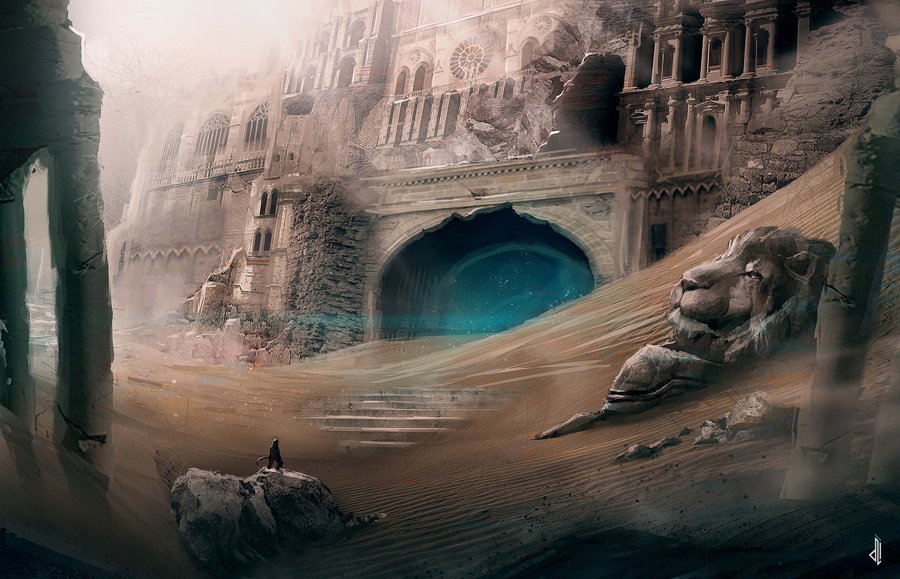
The Legend of Solvheil
Solvheil [sohl-veyl] was once the most powerful empire in Elrithorn that evolved from the birthplace of man. It was located on a landmass in the middle of a vast inland sea which sat in a basin surrounded by mountain ranges.
Rel, the creator, walked with man in the ancient civilization of Solvheil. It was here that arcane and divine magic were at their pinnacle. Priests of Rel possessed the greatest of healing while Solvheilian mages controlled the elements.
While ambition was the heart of man's strength, it was their never ending quest for knowledge and power that ultimately led to destruction. The ancient Solvheilians learned how to harness the gravitational energy of the earth and sea. In their tampering they pushed all of the water of the inland sea outward spilling out of the basin over the mountains.
The result was a catastrophic flood that devastated much of the outer lands and left the inland sea a dry sandy basin without water. Solvheil shook on it's foundation and crumbled from below sinking onto itself and buried under rock and sand.
Cradle of Human Civilization
Many accounts of the beginning of humanity points to a single civilization from which all mankind began. This fabled ancient empire is called Solvheil. Few details are known and what stories have survived the centuries are far from consistent in many regards.
Common theory is that Solvheil was located somewhere in the heart of the Shalihir Desert and was surrounded by vast amounts of water. It is said that the great creator of man walked amongst the populous as a mortal until the time of their betrayal.
It is said to have been a time where divine and arcane magic where at their apex with the one creator guiding the hands of clerics and mages alike. Details of the events of Solvheil's destruction are non-existent but all stories imply that it shook upon it's foundations and eventually sank.
While most believe that Solvheil sank into the sands during the great flood, it in fact sank into an extra-dimensional pocket created during the Tear in the material plane that caused the flood. Because of this anomaly, a majority of the ruins are sunk below the fabric of the material plane and unreachable by conventional methods of travel.
I
Deities

Religion
Before there was time, there was chaos. Absolute lack of pattern or design in a never ending undulating flux. The creator conquered chaos to make order, forced the flux aside to allow for pattern and light. Through order came time and space woven together which set the stage for the material plane.
Religion is as diverse as it is misunderstood across the land. Each culture has a piece of the truth buried within it's tales and practices, but no living mortal knows the whole story. Much of the information regarding the divine comes attached with the caveat, "or so it is said."
Rel
Domains: Sun/Air/Good
Favored Animal Avatar: Bird
Title: Creator, The One True
After Rel created the world he left it alone for some time. Chaos bore demons upon the land which ruled in destruction and contempt. Rel banished them to the underworld and created Ehllelo to do with the land as she wished. It was only some time after that Rel created mankind as his proudest achievement in the heart of an inland sea. So pleased with them, he decided to instill profound knowledge directly with his presence leaving Ehllelo to watch the world from above.
He descended from the heavens and set a human foot upon the ground. Rel walked with man in the ancient civilization of Solvheil. Sacrificing omnipresence and immortality to live along side his creations in mortal form. From them, he chose representatives for his arcane and divine teachings who were placed in high positions of authority within the church.
Several conspired against Rel and tricked him into unwillingly relinquishing some of his divine power unto them. They presented him a golden jeweled sarcophagus as a holy resting chamber which slowly drained his power while leaving his mortal shell continually ill. The Sarcophagus of Rel channeled his power to the powerful crystals below the chamber.
Dogma
And Rel said upon his people, I have assumed your form as I now behold your readiness. I shall share with thee my wisdom and glory so that you may rule the land as I would. What has been forged from the chaos, let no man nor beast destroy...
Water surrounds you and from it is comes life. Guard well the sea for without it the land and all upon it shall die. Water, like all material elements, can serve you well or tear you apart if but for a minute you lose respect for it. Mind well its timeless nature bend before its temperament...
All that lives must eventually die. That is the price that time demands and one tax that always collects. Mark well the sun, for its glory both sustains as well as takes away. Serve the elements well, and through them, serve me...
Beyond the sea to the West lie the keepers of the forest. Tread not in their garden clumsily, but pay homage to the trees. For She has placed them as I have placed you. With that, you are cut from the same cloth but differ in design and purpose...
Arcane magic as wielded by mortal man is but folds and tears in reality. Knowing how to discover and manipulate the chaos that lies beneath the curtain of order. Divine magic is far more potent as man becomes a channel for the true power. Only the faithful and deserving act as an appropriate conduit for the hand of the divine...
Ehllelo
Domains: Plant/Animal/Healing/Good
Favored Animal Avatar: Bear
Title: Creator, The One True

Created by Rel to reshape the world from chaos. Ehllelo created the four elements to sculpt the material world. When it was fit for life, she created all manner of flora and fauna and wove their existences together. Posing as a great bear, Ehllelo planted the Hearleforne which sprung life to the Great Forest of the West. It was from this location that she created the elves to act as the guardians of nature.
Elemental Deities
Veldarish
Elemental Domain: Fire
Sevantha
Elemental Domain: Water
Pulanthor
Elemental Domain: Earth
Glinthana
Elemental Domain: Air
The New Gods
Those who attained divinity during the events that preceded and caused the Great Flood.
- Koth
Domains: Knowledge/Magic
Favored Animal Avatar: Lizard
Former High Priest of Rel- Rackshaa
Domains: Trickery/Evil
Favored Animal Avatar: Dog
Former High Priest of Rel- Rajameni
Domains: Travel/Healing
Favored Animal Avatar: Cat
Former Holy Muse- Threll
Domains: War/Death/Destruction/Evil
Favored Animal Avatar: Ram
Former High Priest of Rel- Torrne
Domains: Strength/Protection/Good
Favored Animal Avatar: Lion
Right Hand of Rel
Patron Race: Humans
Staunchly loyal and fearless in battle in service of Rel before the flood, Tornne commanded a host of sphinx. Clerics of Torrne favor non-bladed weapons.
Golden Dragon
Religion in Orilyn centers around the worship of a nameless Golden Dragon. This deity is said to dwell high in the mountain peaks, atop Mount Dramoto, and hold council with the most elder of the race.
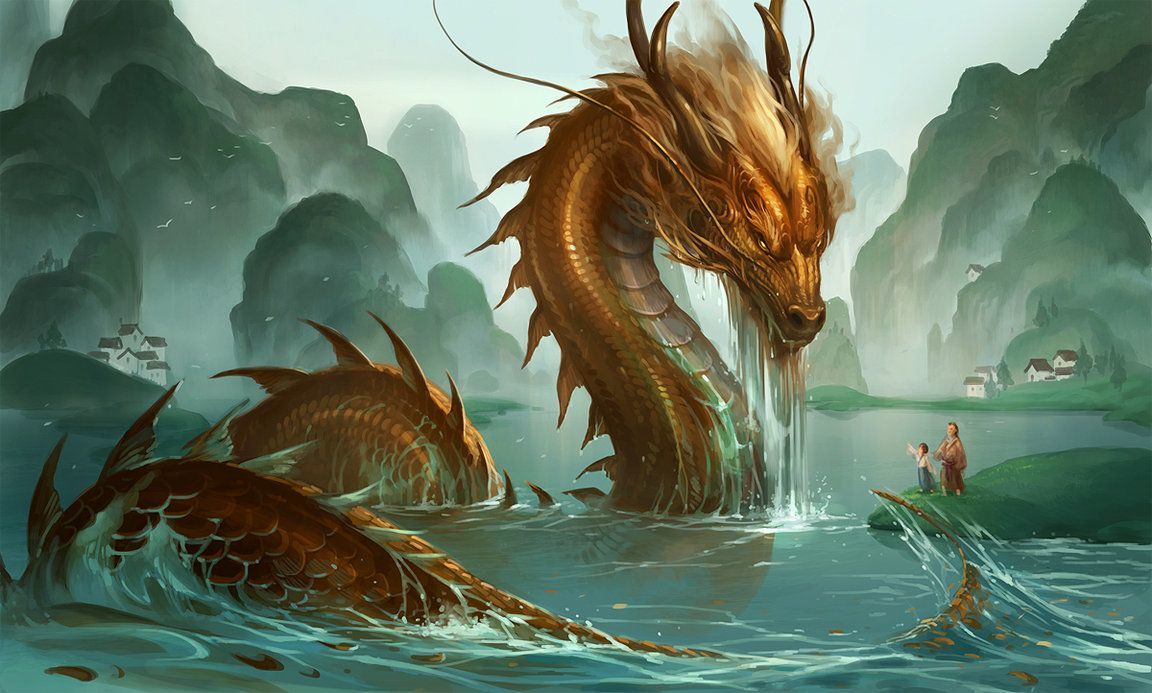
II
Sands of Shalihir
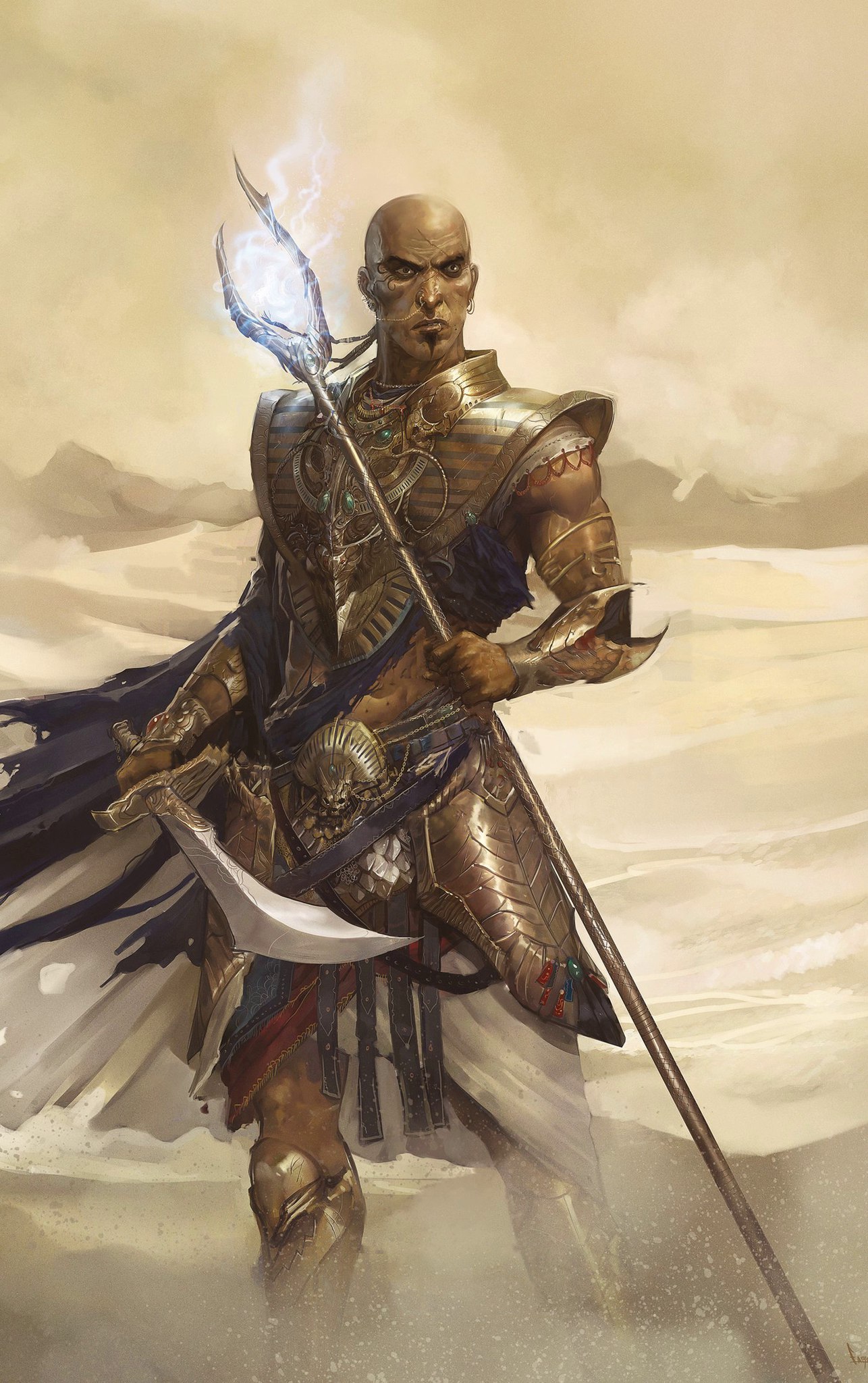
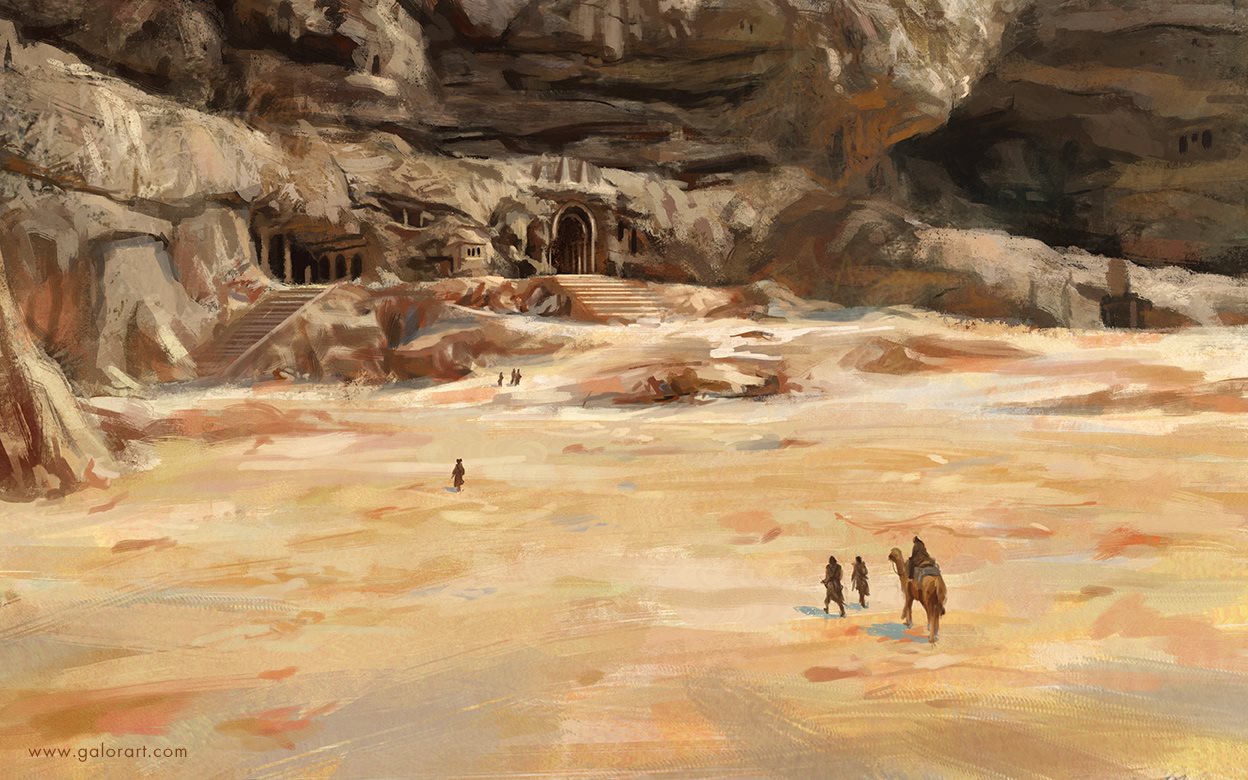
Shalihir Desert
Shalihir [shal-uh-heer] is a desert setting resembling more arid regions of the Middle East. It is ruled under a Sultan, but is in essence comprised of several independent tribes. The Shalihir desert lies between Dalreon to the West and Orilyn to the East lies and in a vast basin surrounded by mountain ranges.
Primarily sanded dunes and flats, it also contains some large rock features that protrude into the sky. The land is ruled by a Sultan who resides in a palace in Quil N'aair.
- Ruler: Sultan Verlan
- Capitol: Quil N'aair
- Magic: Magery
- Healing: Alchemical
Shalihir is a savage and fierce mass of burning sand and deadly inhabitants. What law exists there is clustered in its few settlements. Hordes of black orcs and other tribal beasts tear through pillaging all in their path. Some of the most lethal of all wild creature call the Shalihir their home.
The use of magic among men is higher in the desert than anywhere in the known world. It is not uncommon to find a street mage or two in town, or find rogue mages living in solitude.
It is said that all of humanity originated somewhere in present day Shalihir when the great desert was once a mass inland sea. When the legendary kingdom of Solvheil knew man at its most powerful. The people of Shalihir maintain their lineage is closely tied to the lost kingdom and that is the reason for their arcane nature.
Towns and Settlements
The various population centers of Dalreon
- Quil N'aair * (capital)
- Tahamman
- Oasis of Azullain
- Zhahinn
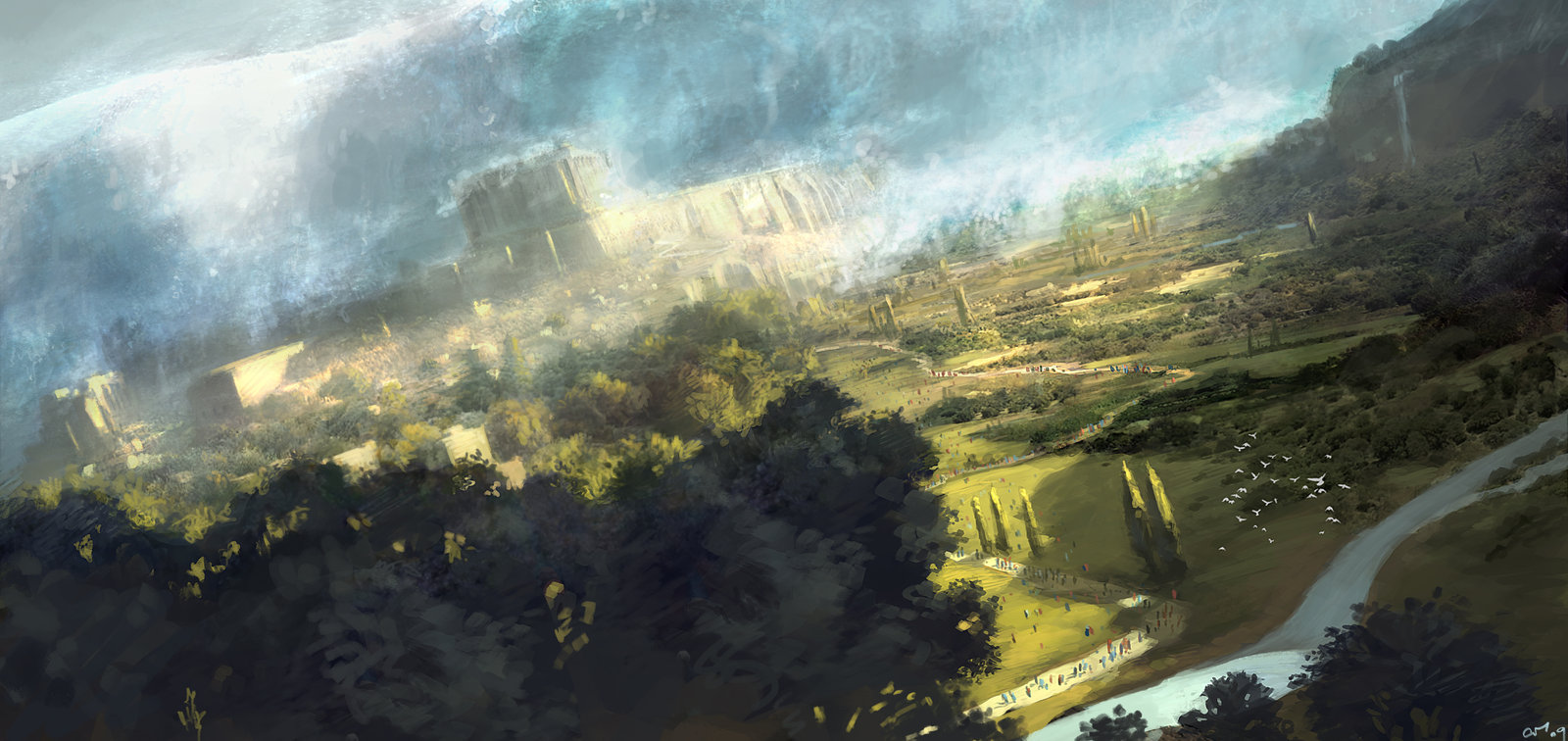
The Flood
The Flood, or Great Flood, generally refers to the time in history when the Imlan Sea spilled from its mountain basin and washed across the outlying lands. What once held the seawater dried to become the desert of Shalihir. This event is tied to the destruction of Solvheil.
Results
The following places were dramatically affected by the flood:
- Imlan Sea: Expelled to become Shalihir Desert
- Solvheil: Destroyed
- Cardobah: Destroyed
- Ulnara: Destroyed
- Nalass: Destroyed
- Kazatharis: Destroyed
- Orilyn: Turned into wetlands
- Great Forest: Large area became Barl Swamp
- Archonvale: Damaged as Hearleforne roots are flooded.
"The time of gods and men ended with the flood. When those who sought to attain their own divine portfolio tilted the world on its axis. The floodwaters washed clean the slate, started everything anew.
It is now in mortal hands that the fate of society rests, while the pantheon watch from behind the veil. Without divine hand-holding, mortals are often left questioning the purpose of their lives.
This uncertainty can either fill one with thought and wonder, or empty sorrow."
-Shalihir Philosopher

Sinking in the Sands
While most believe Solvheil sank into the sands during the great flood, it in fact sank into an extra-dimensional pocket created during the shift in the material plane which caused the flood.
Because of this anomaly, a majority of the ruins are sunk below the fabric of the material plane and unreachable by conventional methods of travel.
The result of mortal tampering in both arcane and divine magic, the flood would forever reshape Elrithorn. Ancient man was forever cut off from his pinnacle of advancement and returned to a more simple and primative form while the whole world shared in the price.
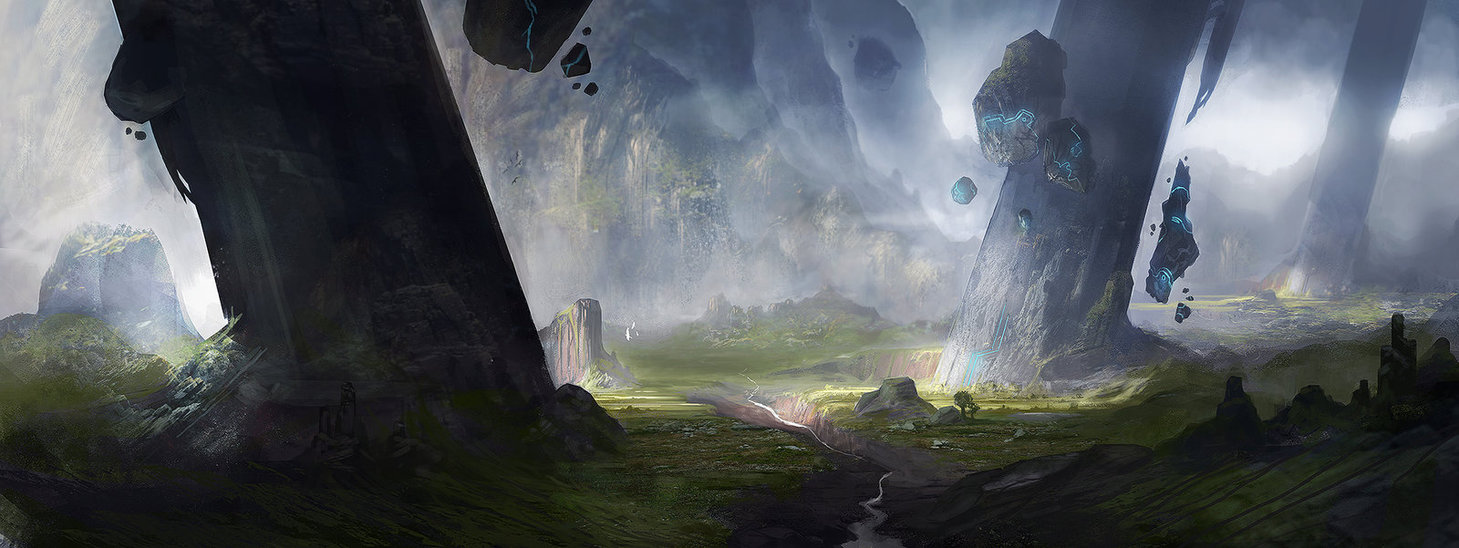
Primative Return
Empires of the Imlan Sea
- Solvheil
- Cardobah
- Kazatharis
- Nalass
- Ulnara
Centuries had passed since the Imlan Sea expelled its waters, leaving behind a sandy seabed which became the Shalihir desert.
All of the lands beyond the surrounding mountains drank the floodwaters, and the divine folly of man destroyed his birthplace as Solvheil was swallowed by the sands. Whatever wonders had existed in the old world were gone, replaced by a new world, scarred and barren.
Scattered were the humans of Solvheil, and the once prosperous kingdoms of the Imlan Sea; Cardobah, Ulnara, and Nalass.
Surviving tribes of men were eventually enslaved by beasts, by demons, and of course, by other men. Men who could control both beast and demon, men whose practice of arcane arts had made them seek both knowledge and power with reckless abandon.
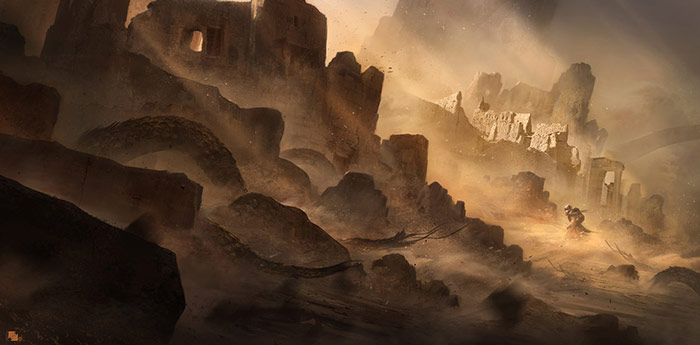
Magocracy
Magic was almost completely lost in the flood and destruction of Solvheil. Nevertheless there were those who survived still gifted in the arcane arts, and they quickly rose to power.
Many tribes of men in the newly formed desert were unwilling servants of these sand mages. Forced to work in constructing their towers, used in experimentation, or being sent on deadly quests to recover artifacts.
Spellcasting was forbidden among the common, and even advanced literacy was discouraged as those in power feared an uprising of the educated and determined.
The Age of Burning Towers
A time of revolt in Shalihir when the mundane overthrew their magically adept rulers. After generations living in fear of their arcane overlords, humans were finally given a fighting chance at rebellion.
Man had encountered dwarf in their assigned journeys. Remembering their own former enslavement by the goblinkin, it was Dwarven Stonecutters who taught man to read through runic script.
It was also great fortune to have rediscovered the Sarcophagus of Rel, a powerful artifact from Solvheil that still held some divine power of the Creator. Carried by several men via poles along the side, it could be used to expel great amounts of directed energy.
Durina the period known as the Age of Burning Towers, man used the Sarcophagus of Rel to destroy the strongholds of those who ruled them. After the mages were overthrown, man began anew yet again rebuilding society from its ruin.
Not long after, the sarcophagus once again fell into legend as it was lost to time.
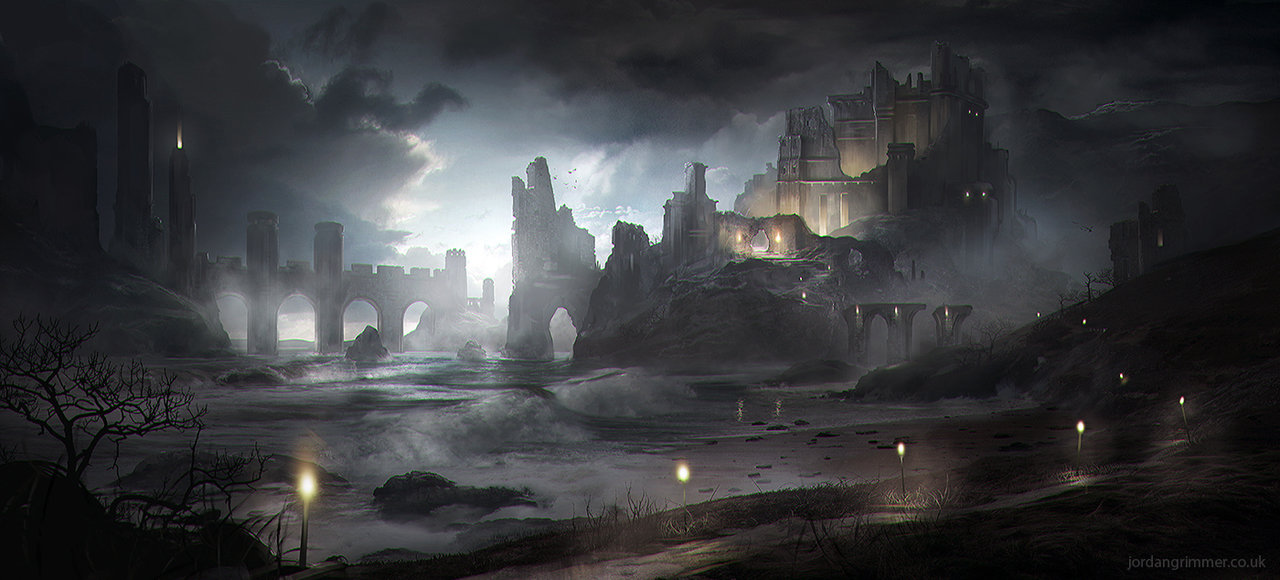
Ruins of Kazatharis
Once a thriving port on the western edge of the Imlan Sea, early pioneers from Solvheil built this fortress of a town into the Crenmantle Mountains directly above some old dwarven halls.
Before the massive flood that expelled the Imlan Sea, most residents escaped west to the areas that would eventually become Dalreon and Harrn.
The tidal waters were held at bay by a collective effort of mages and bards combining spell and song to form a barrier. Though almost all were killed holding back the waves, their efforts secured the escape of humanity.
The city mostly crumbled, the docks now dry. What remains of Kazatharis stands as an abandoned shell overlooking the desert sands where there once was a sea.
There are two approaches to the ruins of Kazatharis. The first is from the Shalihir Desert on the East with a treacherous climb below the now dry docks. The other is a pass through an ancient dwarven hall in the Crenmantle Mountains connecting the Barl Swamp below to the ruins plateau.
While the city has largely been laid to waste, there are still numerous structures that survived the deluge and hold both mysteries and perils from the ancient world.

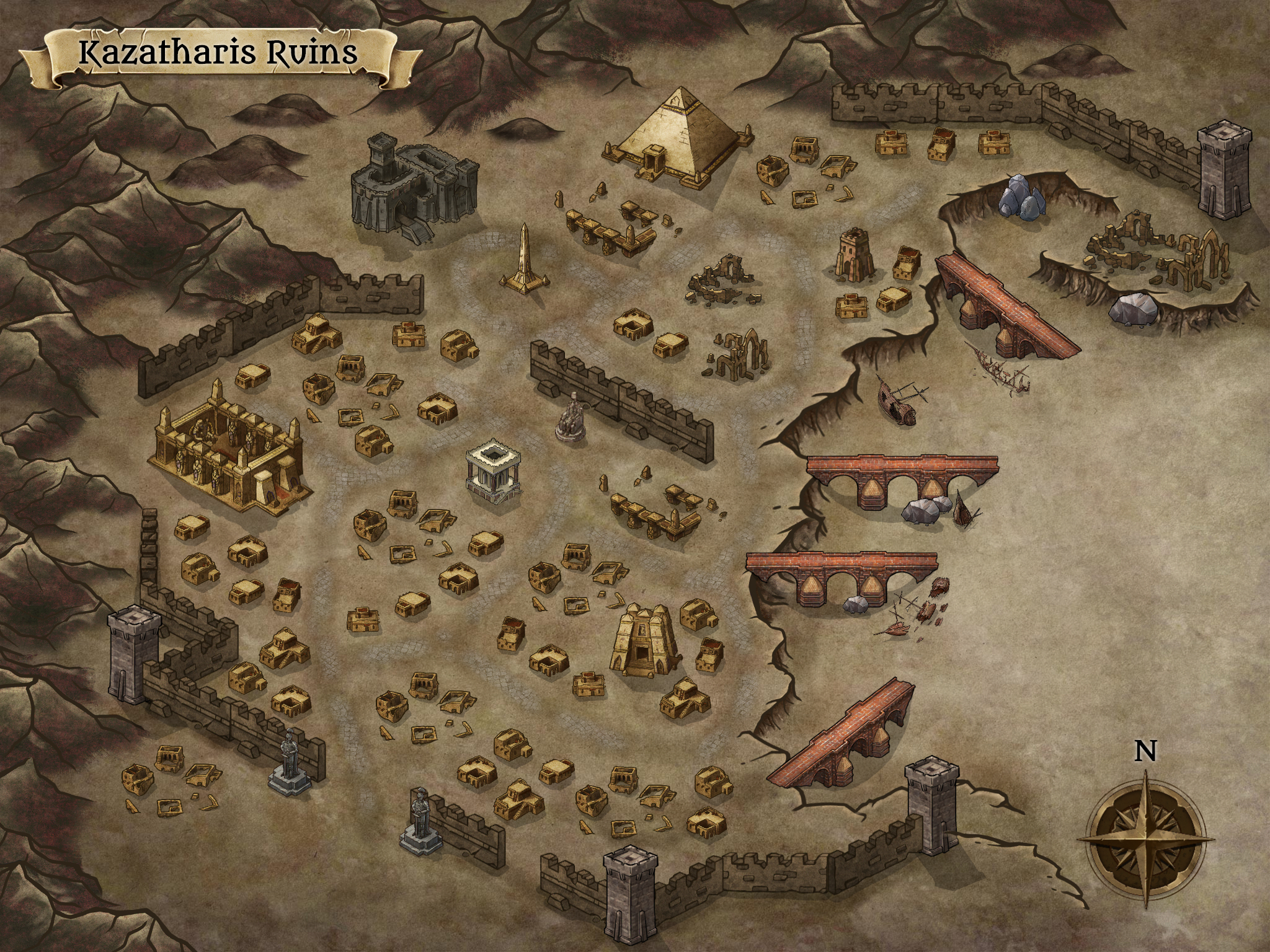
Kazatharis Map
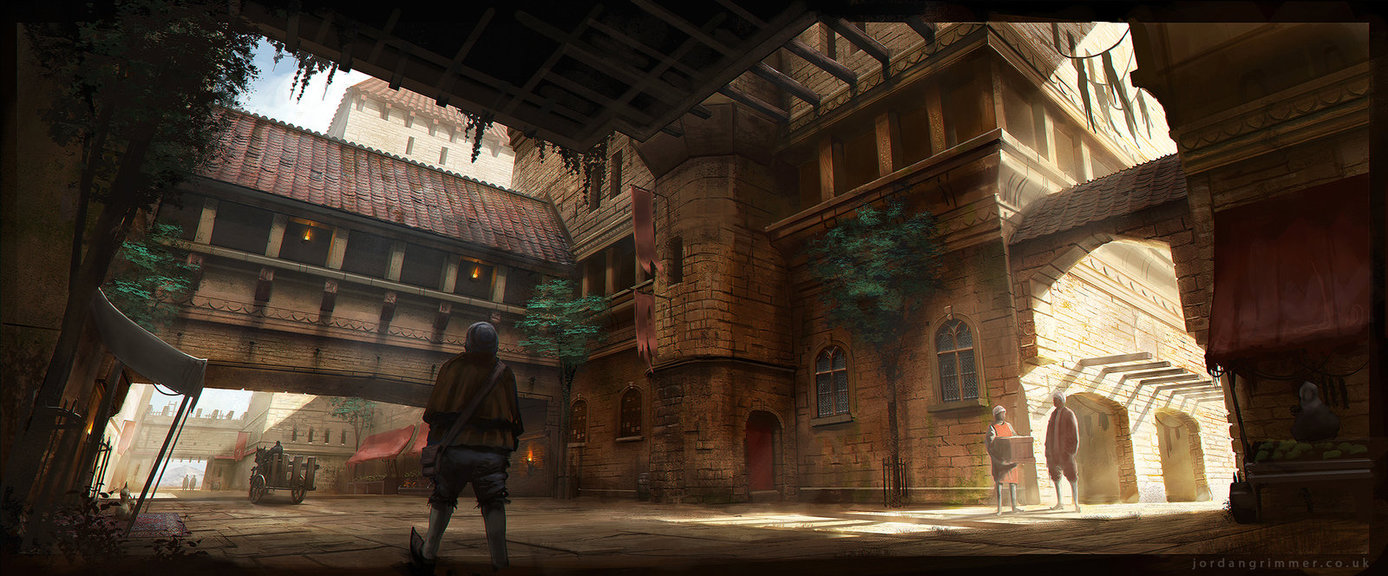
Quil N'aair
The largest city in Shalihir is also its Capital. Quil N'aair is built at the base of the large landmass that once was home to Ulnara. While not a direct stop on the main trade route between the East and West, Quil'Naair still enjoys a vibrant economy and serves as the political center of Shalihir.
Places of Interest
- The Silver Sphinx Inn
Proprietor: Ehlann Fahrish- The Boundless Chalice (Tavern)
Proprietor: Dashyrr Kahnola- Moukmed's Alchemy
Proprietor: Moukmed Felladd
Oasis of Azullain
Large oasis in the Shalihir desert. It was originally discovered by the explorer/adventurer Azullain, and quickly became and important watering hole and trading post along the caravan routes.
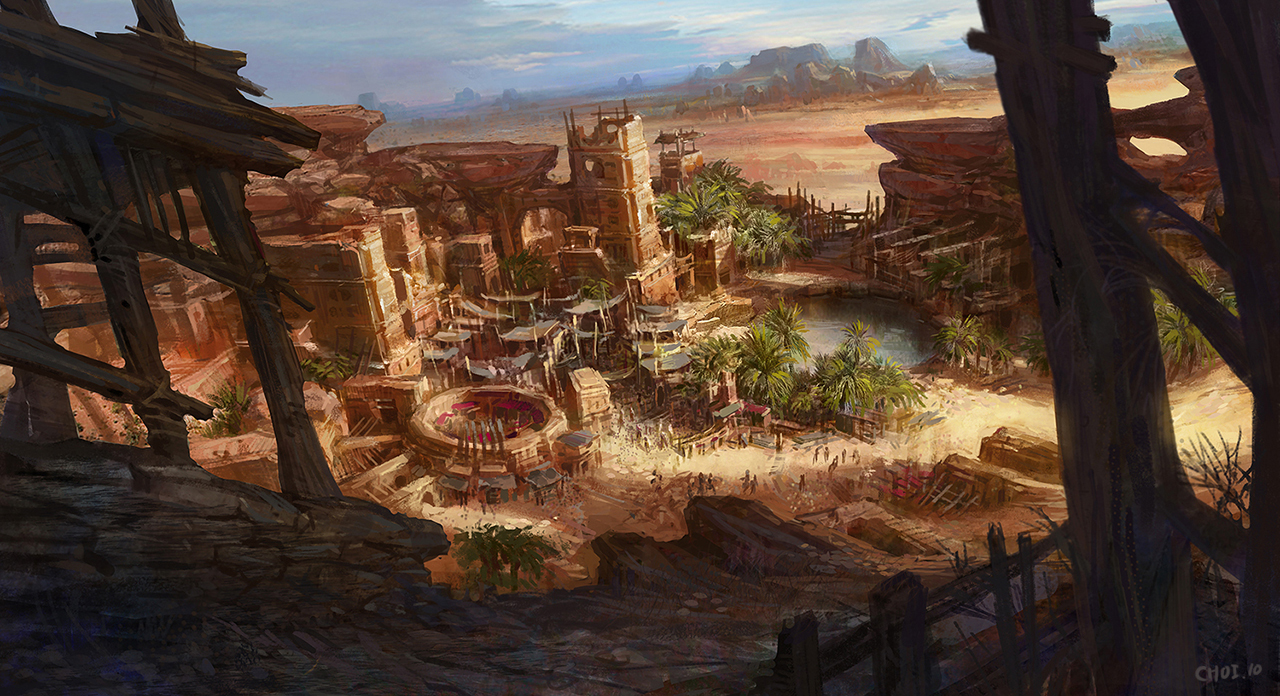
Tahamman
Tahamman is the Westernmost human settlement in Shalihir. It acts as Dalreon's gateway to the desert with its close proximity to Albrynn separated by a mountainous pass.
A true desert trade town, Tahamman is crossways for many different cultures and walks of life. What would sound the town bell in Dalreon barely raises an eyebrow here.
Places of Interest
- The Empty Hump Tavern
Proprietor: Bimbalish Felladd- Najif's Ore-asis
Proprietor: Najif Ulearas- Armond Alchemy
Proprietor: Zeihnol Armond- The Blade of Sand (Weaponsmith)
Proprietor: O'rleat Krelnn
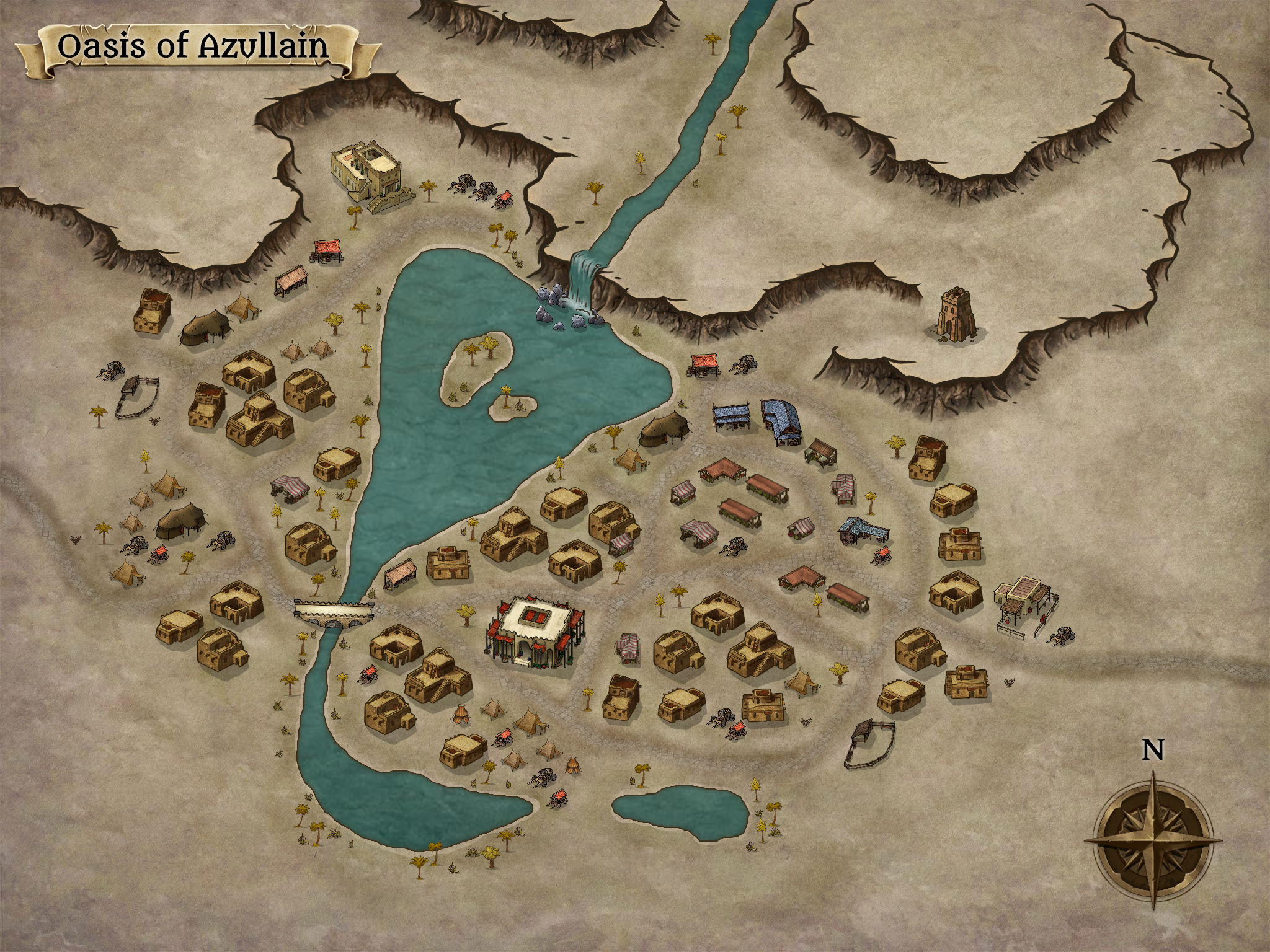
Oasis of Azullain Map
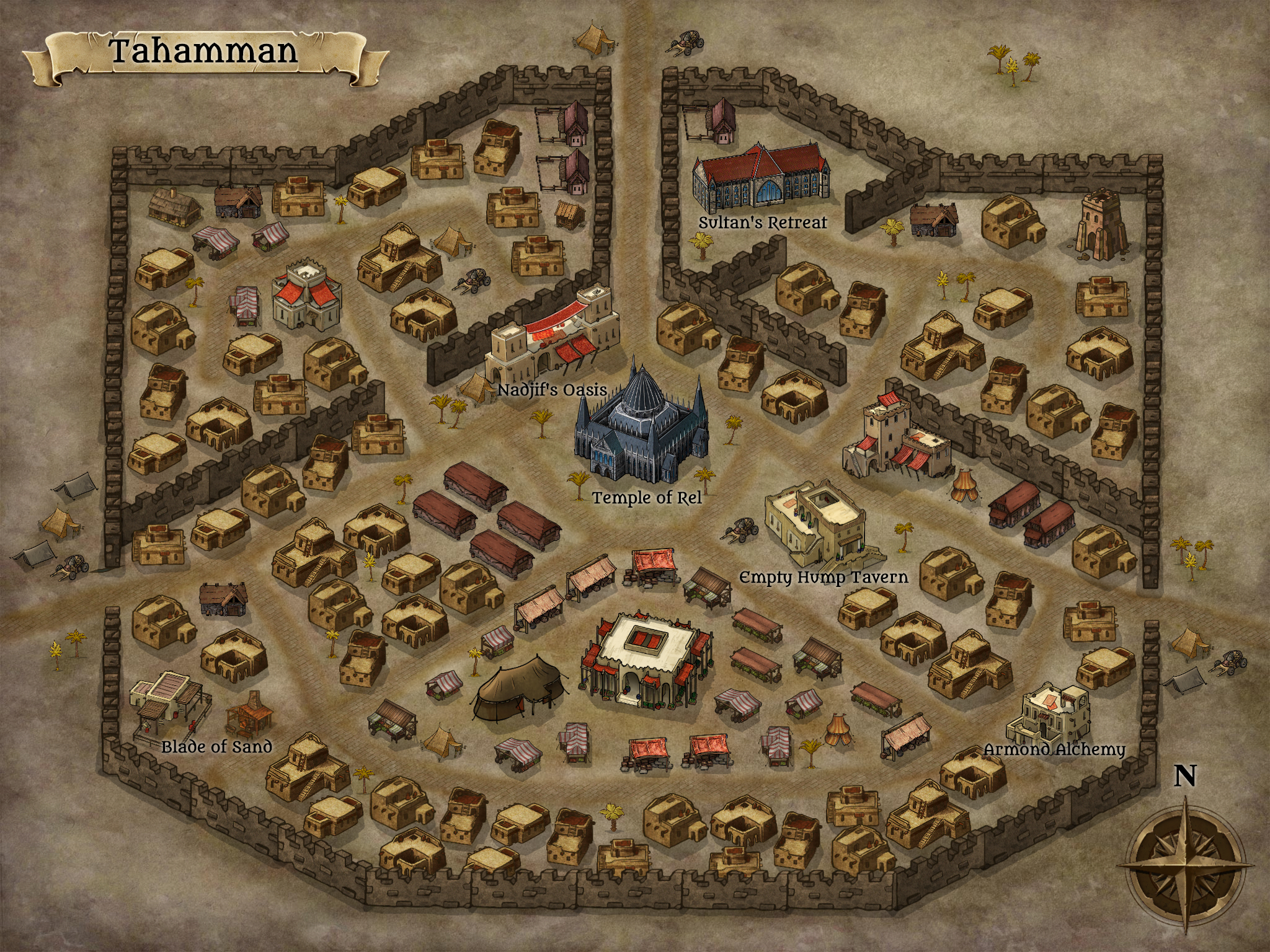
Tahamman Map
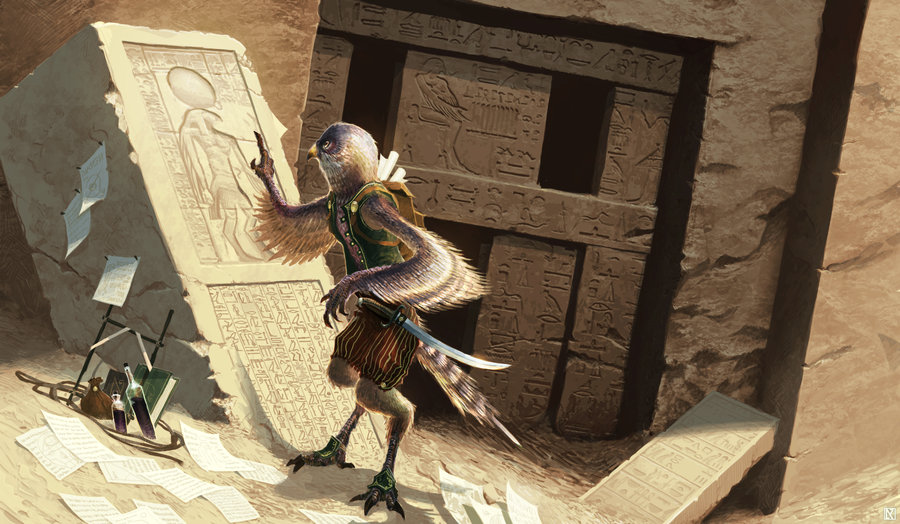
Ritual of Return
Entering Solvheil is not as easy as walking across a breach. There is only one known stable portal to the hidden dimensional pocket, and it requires elaborate detail to manifest.
Most of the details are broken or lost to time, and no one has a complete list of all of the requirements.
- Shape: The runic pattern of Alakanthor and Portal Stone
- Sound: The ringing bells of Alakanthor in harmony
- Color: The lost color
- Material: Of specific textile and weave
- Scent: Specific Incense
- Lighting: Candles set behind colored glass
Shape of Alakanthor
The monastary/temple known as Alakanthor was built by the Dwarven Stonecutters Guild into a perfect runic pattern. The very floorplan itself takes the shape of an ancient passage rune.

Bells of Alakanthor
Three bells crafted by the finest metalworkers the mountains had to offer, and designed to create a specific harmonic frequency when used in unison. Their specific placement atop the structure directs the focal point of the tone at the Portal Stone.
Color Lost to Time
Said to be beautiful color of divine majesty somewhere between blue and gold. The color is created from the ink of a beast found somewhere in the Sea of Aluun.
Material for Shroud
The Portal Stone must be adorned with a fabric shroud of a specific pattern of weave and dyed in the lost color.
Placement and tint of light
Even the lighting requires special care as candles must be set in specific sconces, and their flicker filtered with a tinted screen.
Alternate Portals
There are legends of other portals even more obscure than Alakanthor, such as the Blood Portal in the deep jungle, or a portal at the bottom of the Sea of Aluun.
None so far have been confirmed, and there are no known parties that have successfully found the ruins of Solvheil. Possible plot hooks could involve powerful groups either seeking these lost details or preventing their discovery.
III
Elves of Lyritholln
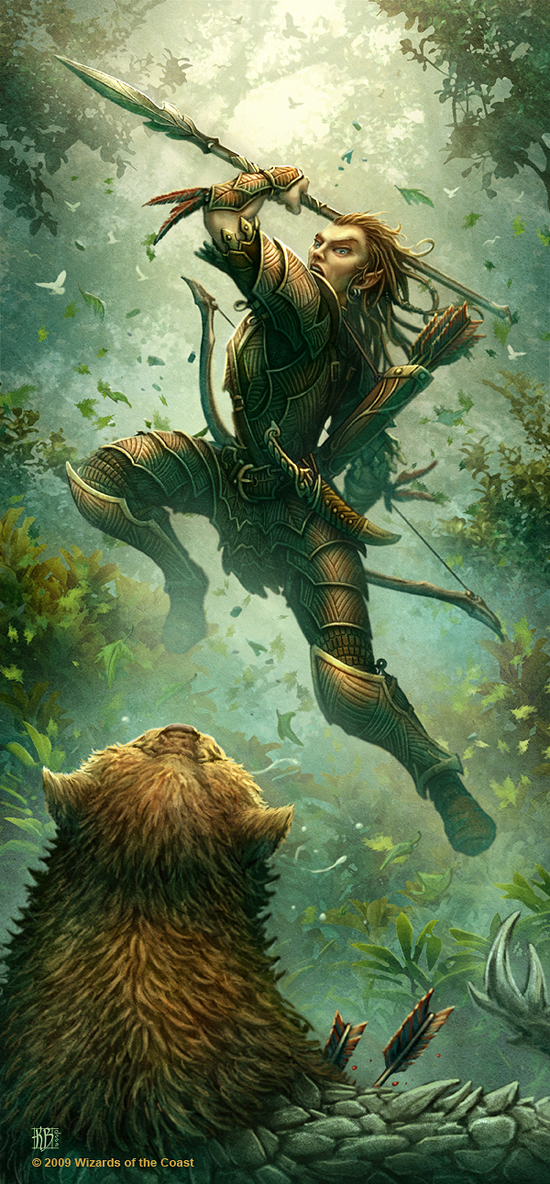
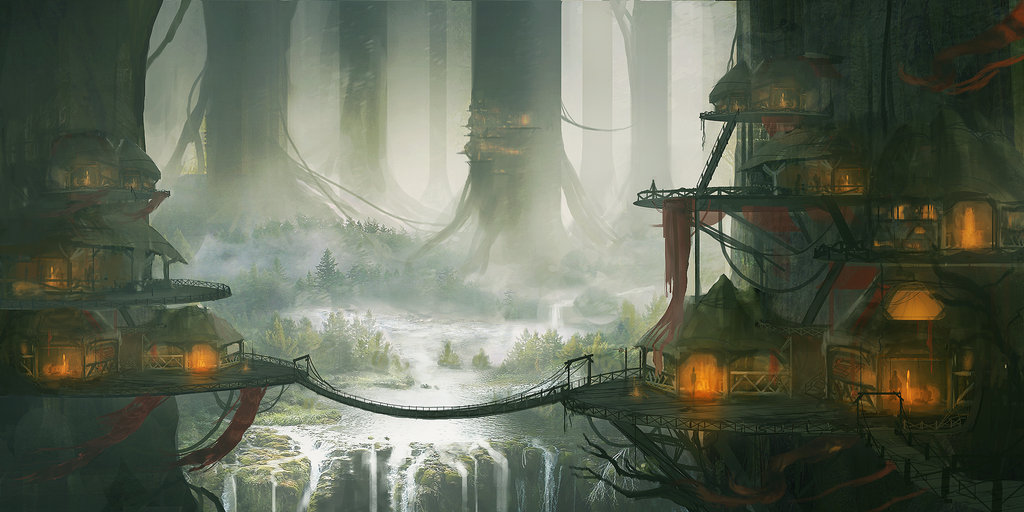
Lyritholln
Also known as "The Great Forest" in human tongue, Lyritholln [leer-uh-thawln] is a massive wooded region of deep forest and towering trees completely contained within the Kingdom of Dalreon, although it is much older than the human kingdom around it.
Lyritholln is a kingdom not in the civilized sense, although there are settlements. It encompasses a majority of the Great Forest situated around Hearleforne tree, and the Elves fiercely defend its borders.
Settlements in Lyritholln and very non-intrusive of their surroundings, and are built into the natural structures. The most common design consists of tree-top dwellings connected by walkways and bridges. While less popular are the earthen structures built into the ground and cave structures.
- Ruler: Elrinne
- Capital: Archonvale
- Magic: Common
- Rivers: Thynoth River
The Hearleforne
Believed by fae to be the axis of existence, and fulcrum of the Material Plane. Ehllelo planted the Hearleforne which sprung life to the Great Forest of the West. Its name translates to "Heart of the Forest", as it was the first plant to grace the presence of the ground, and stands to represent all that is green and grows.
Because of this, it is protected by the elves and supported by all of the elements, who themselves are original creations of Ehllelo. Through the elemental primes, the Hearleforne thrives as uses each gift individually.
Pulanthor grants it a base and source of nutrients, while Sevantha feeds it from above and below with Glinthana who cools it helps it to breath, and Veldarish stays clear from harming it and burns the forest of that which is dead to return their essence to the ground.

During the great flood, the depressed ground around its mighty roots became flooded with water from the Imlan Sea.
At first, the Hearleforne appeared weakened by this ecological change, but eventually adapted and thrived once again. For this, the elves rightfully blamed humans, which soured relations between Lyritholln and the fledgling settlements of refugees.
Archonvale
The Hearleforne houses more than the center of the natural world, it is also the home of the elven capital of Archonvale. The Lyrith Elves have made their homes among the plentiful and reaching branches, and nested around the ancient roots of the great tree.
A far cry from the metropolitan fashion of other kingdom's capitals, Archonvale leaves the influence and structure to the existing flora, instead living among what nature has provided instead of bending it to their will.
Elegant and organic best describe the architecture, with flowing curves and symmetrical spirals forming patterns a far cry from the rigidity of dwarven runes. Bridges and stairways connect the districts that surround the cradling grasp of the Hearleforne.
The Aluriel family still rule in Lyritholln. With Eldrynn long since passed, Elrinne Aluriel now wears the elven crown. Where he lacks in physical capacity to be like the champions of old, he makes up in thoughtful contemplation and measured stoic wisdom.
With much of their history and knowledge lost to the flood, the elves have settled again into their role as defenders of the forest.
Lyrith Elves
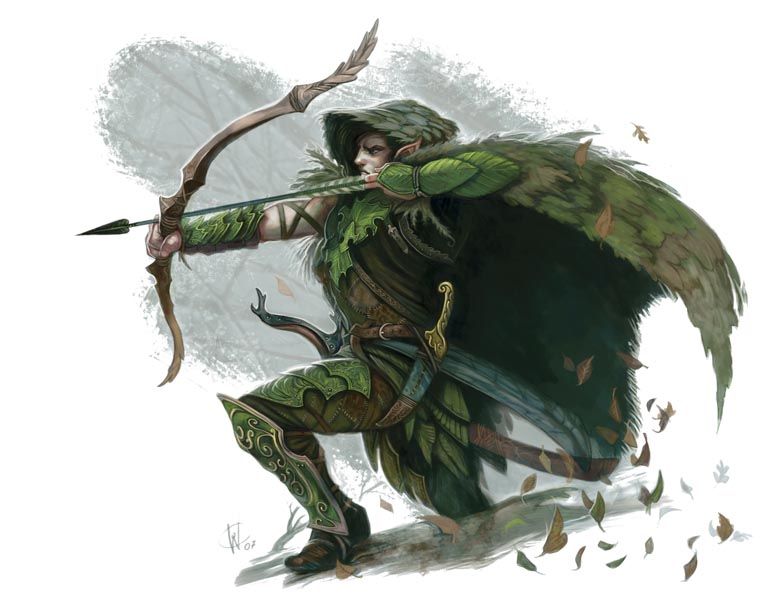
Elves are slightly shorter than humans and display a fair skin tone and mainly blondish brown to white hair. They also display sharply pointed ears and a slim build. Elves are also among the best archers due to their natural dexterity and heightened senses.
Elves enjoy a long comfortable lifespan of a couple centuries and share a bond with the forest they were created to protect. Their reverence for nature and the elements, as well as their worship of Ehllelo, grants them druidic magic. This power is greater when within the bounds of the forest because of the density of the vegetation.
Although Lyritholln is within the boundaries of Dalreon, they consider themselves and the Great Forest sovereign and fiercely defend its borders. Relations with Humans is tense due to the destruction of parts of the forest from both the flood, as well as deforestation as humans settled the land for agriculture. This with the flooding of the Hearleforne, whom the Elves are sworn to protect in the name of Ehllelo, caused a great schism between the two races.
The humans of Dalreon may have long forgotten what caused the flood or the extent of the destruction it wrought, but the elves have longer memories and hold man accountable for their past travesties. Their relations with the dwarves of the North are strictly emmisarial as their ideologies and cultures greatly differ.

Ballad of Eldrynn and Illithan
Much of the history of the Lyrith Elves is contained in the story of brothers Eldrynn and Illithan Aluriel, as their actions shaped much of what became of elven society. Many stories, poems, and songs have been written about the ill-fated brothers as both historical accounts and cautionary tales.
The Goblinkin Wars
Beginning when the Northern Goblin Hordes united under the Goblin King, who although an Orc, realized that he had a better chance of bringing them all under one banner by finding common cause in the blood that united them.
Goblinkin fell upon the Northern dwarven kingdoms, enslaving captive artisans to further their advancement with forged weapons and armor. As they moved South, they got stronger both in numbers and equipment.
By the time they passed the Stoneclef Mountains to invade Lyritholln, they were a full-fledged army. Distance from the Northern dwarves and lack of diplomacy gave the Lyrith Elves little warning, as their scouts did not venture North of the mountains.
When the Goblinkin Army reached the forest, they came in greater organized numbers than had ever pierced the treeline before. What elves survived the initial onslaughts were left wondering why they had been outfitted so well in dwarven gear, and initially believed themselves betrayed by their mountainous neighbors.
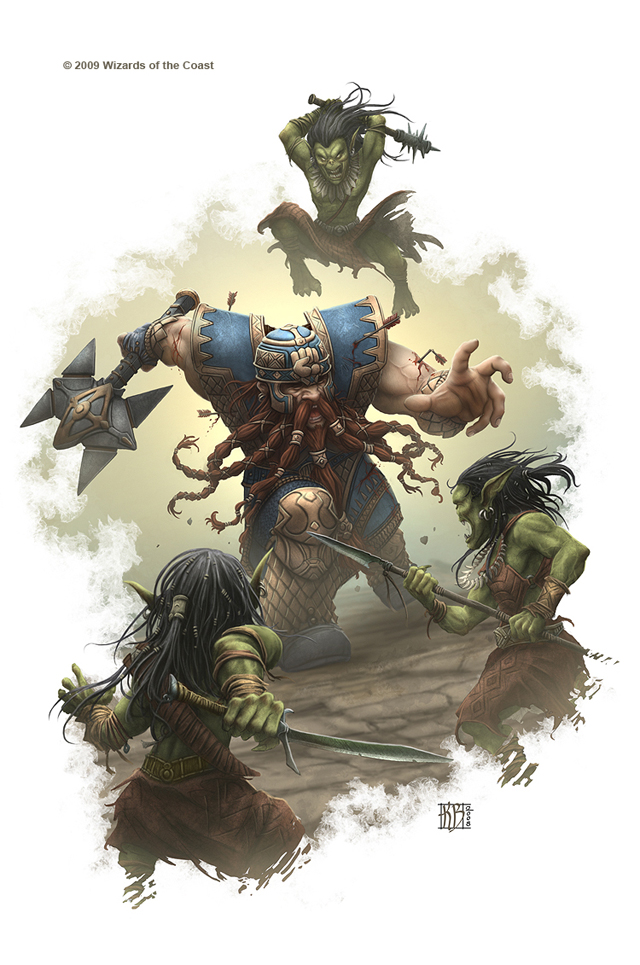
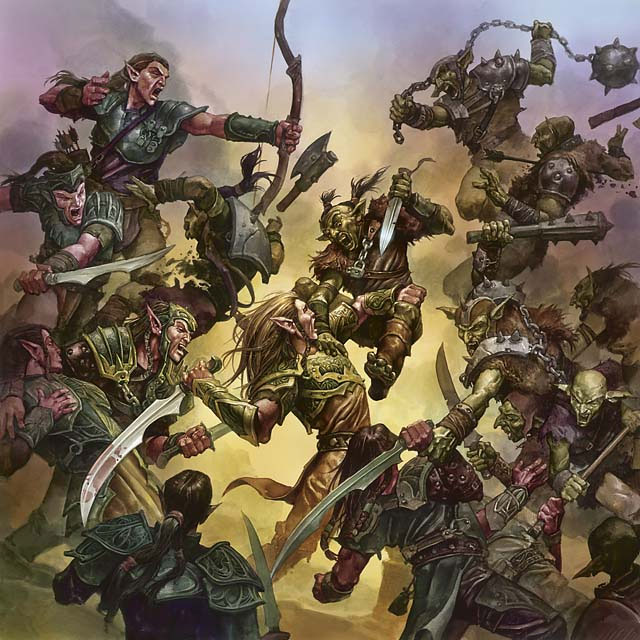
Dwarves always felt elves viewed themselves superior to them partially because dwarves were forged by Pulanthor, who in turn was created by Ehllelo.
Already tense relations between the elves and the dwarves furthered soured with one believing the other had armed their aggressors, while the other believed that they had been abandoned to the horde.
Goblinkin made their way to the forest capital of Archonvale at the Hearleforne in a final push to eradicate the Lyrith Elves. Having overwhelmed elven forces at every outpost and settlement along the way, they had grown in confidence, armament, and intel.
All manner of elven rangers, druids, wizards, and rogues alike banded together in a final stand to save themselves, Archonvale, and the Hearleforne.
In a move of desperation, the elven champion Eldrynn charged the Goblin King and beheaded him. Hoisting the severed head high to show the goblinkin their fallen leader he scattered the hordes in fear. Without defined leadership, the hordes once again fell to entropy and digressed to smaller tribal factions.
This facinated his younger brother Illithan who had led the arcane defense. If a simple decapitated head could ultimately win a war that arrow and blade could not, was there more to be learned in the symbolism of death.
After the forest was secure again, Illithan vowed to take a group to venture out of the forest in search of additional methods of defense to prevent another invasion of that scale.
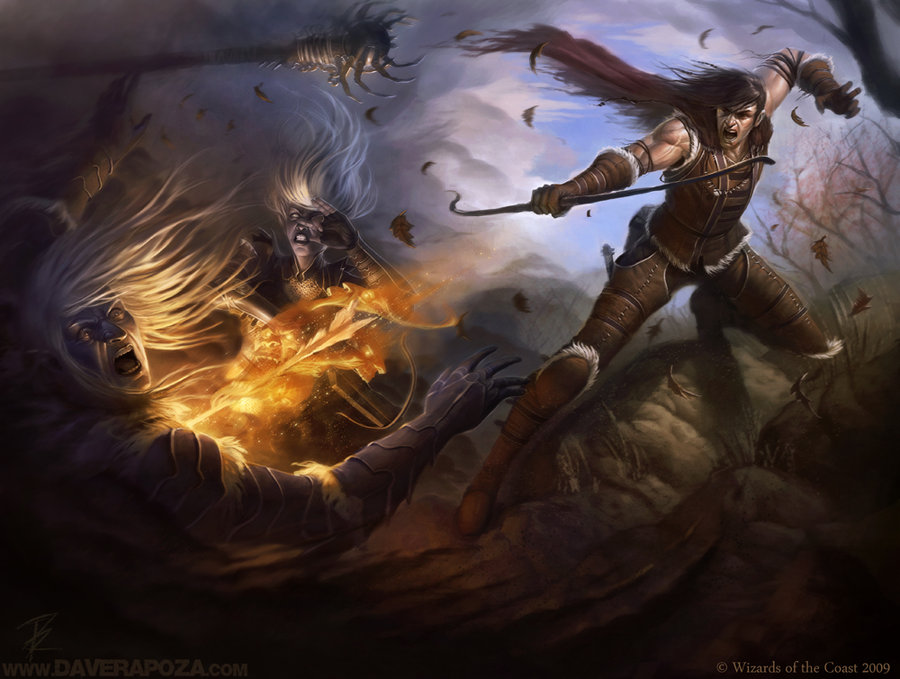
Elven Rebellion
They took the name Ith'inaar, which means "Away from home" in the elvish tongue. Illthan's journey beyond the forest led him East to the Imlan Sea, and eventually to the ancient human kingdom of Nalass.
There he learned of the forbidden practice of necromancy, and the tampering of the veil between life and death. Secret sects of Threll from Solvheil raised corpses from the dead and bound them to their will.
This made sense to Illithan as he had already witnessed a fallen adversary used to stop a war when his brother Eldrynn scattered the Goblinkin Horde with the Goblin King's severed head. If such a simple gesture could save Archonvale, imagine what could be done by raising fallen enemies to be used as defensive force.
These elves away from home learned the dark arts from the humans, and returned West to Lyritholln to share the fruits of their expedition. Expecting to be lauded as heroes for their efforts and innovation, they were instead rebuked as the other elves in Archonvale viewed necromancy as a slight against nature, and Ehllelo herself.
Illithan refused to acquiesce to the demand of ending all practice of necromancy, and he and his followers were cast out of the Great Forest. The splintered group who were once Lyrith Elves were forever branded as the Ith'inaar as a reminder that they would forever be away from home.
Vowing revenge for the percieved betrayel, Illithan led them again West, this time to the Crenmantle Mountains. It was here that their acts would forever stain them and drive them further from what they had started as.
The Ith'inaar raided the Crenmantle Dwarves, slaughtering and raising the fallen as they worked there way deeper into the mountain. Illithan harbored little more than disdain for the dwarves after the Goblinkin War, and viewed them more as a resource than a sentient race.
The dwarves of Crenmantle were little match for the invading elven outcasts. With every battle their numbers dwindled while the undead sent against them grew in strength. They retreated to the deepest depths of the mountains, but there was no escape.
Backed into the farthest of mines, the last of the remaining forces of Crenmantle Dwarves were overcome by their fallen brethren, leaving the Ith'inaar to rule over their ancestral home.
The Darkfall
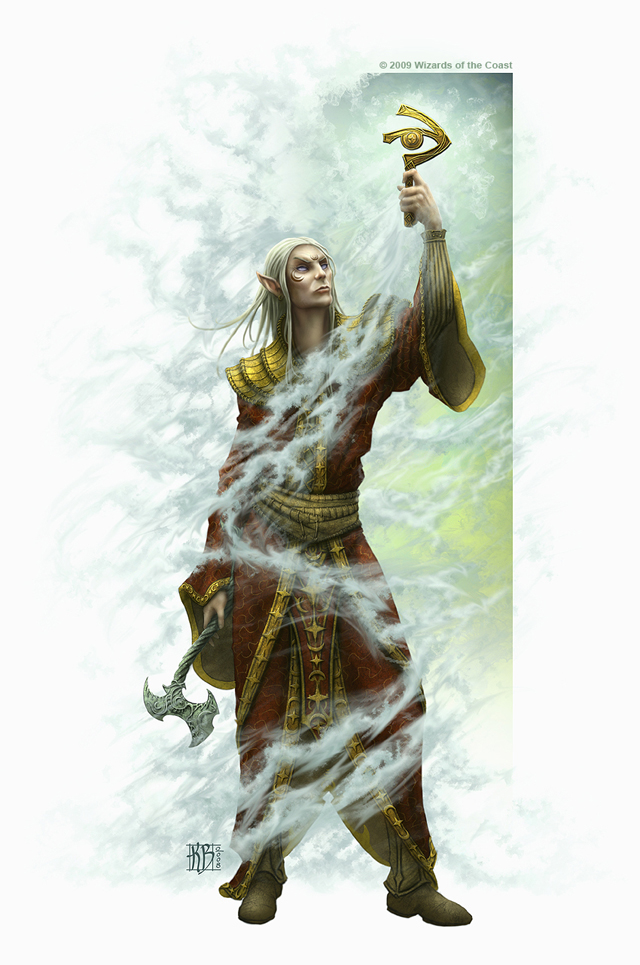
Illithan Aluriel, still in his Lyrith form
Transformation
Not understanding runic magic and architecture that served as dwarven protective wards, the Ith'inaar inadvertently released an ancient evil that had been trapped deep beneath the Crenmantle Mountains. It was a pact with this chaotic force and their turning away from Ehllelo that caused "The Darkfall" forever changing their appearance.
Their skin darkened to match the night sky, while their hair faded bone white. Their eyes also took on unnatural tints such as violet or red, as the foray into the mountainous depths permanently altered their vision to be attuned to darkness, leaving them with bright light sensitivity.
Consequently, this also led to their discovery of the massive underground known as Hollowdown (the Underdark).
Whatever part of them that had once been Lyrith Elf was forever erased as the dark communion left its mark both on the surface and deep within. The Ith'inaar were now Dark Elves, a twisted reflection of their forest origin. They no longer served nature, for they worked actively against the natural cycle and sought to subvert life and conquer death.
Illithan Aluriel, one-time prince of Archonvale and devoted brother, had become evil and twisted and bent on revenge against Eldrynn for his exile.
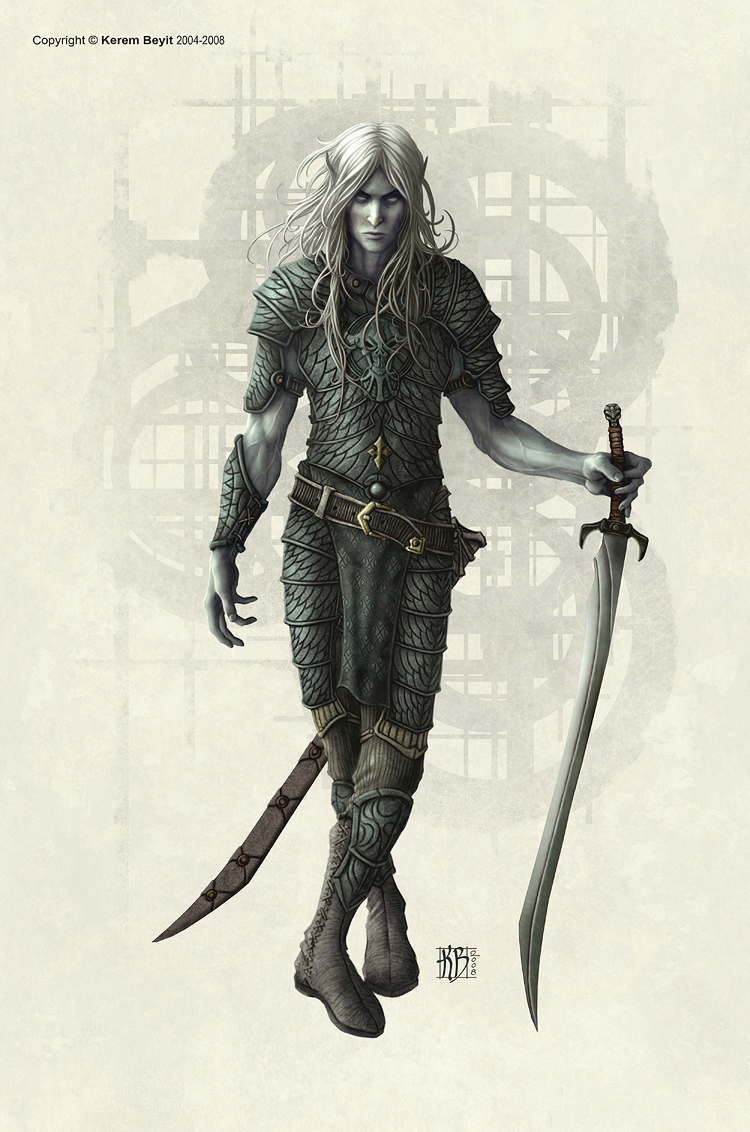
The appearance of an Ith'inaar after the Darkfall
Return to Archonvale
Their skin changed and their souls tainted, the Ith'inaar were driven now more than ever for revenge on Lyritholln. Illithan sought the crown to rule over the Great Forest and further his murderous conquest over Ehllelo's creation. For any place so teeming with life represented untapped resources and undead minions.
Leaving the Crenmantle Mountains to march on Archonvale, the Ith'inaar slew and raised bears, knowing their religious significance. Illithan's memory of symbolism would prove effective as initial battles left the Lyrith Elves in a state of disarray as they were not permitted to harm bears, in reverence to Ehllelo.
By the time they reached Archonvale, Ehllelo herself had blessed Eldrynn's spear, and charged him to defeat his brother in defense of The Hearleforne.
Eldrynn wounded and defeated his brother Illithan, stabbing him with the blessed spear and driving the Ith'inaar again out of Lyritholln as they retreated to the darkness of the Hollowdown.
Eldrynn Aluriel, two-time savior of Lyritholln, would go on its champion, while Illithan and the Ith'inaar were forever banished from the forest.
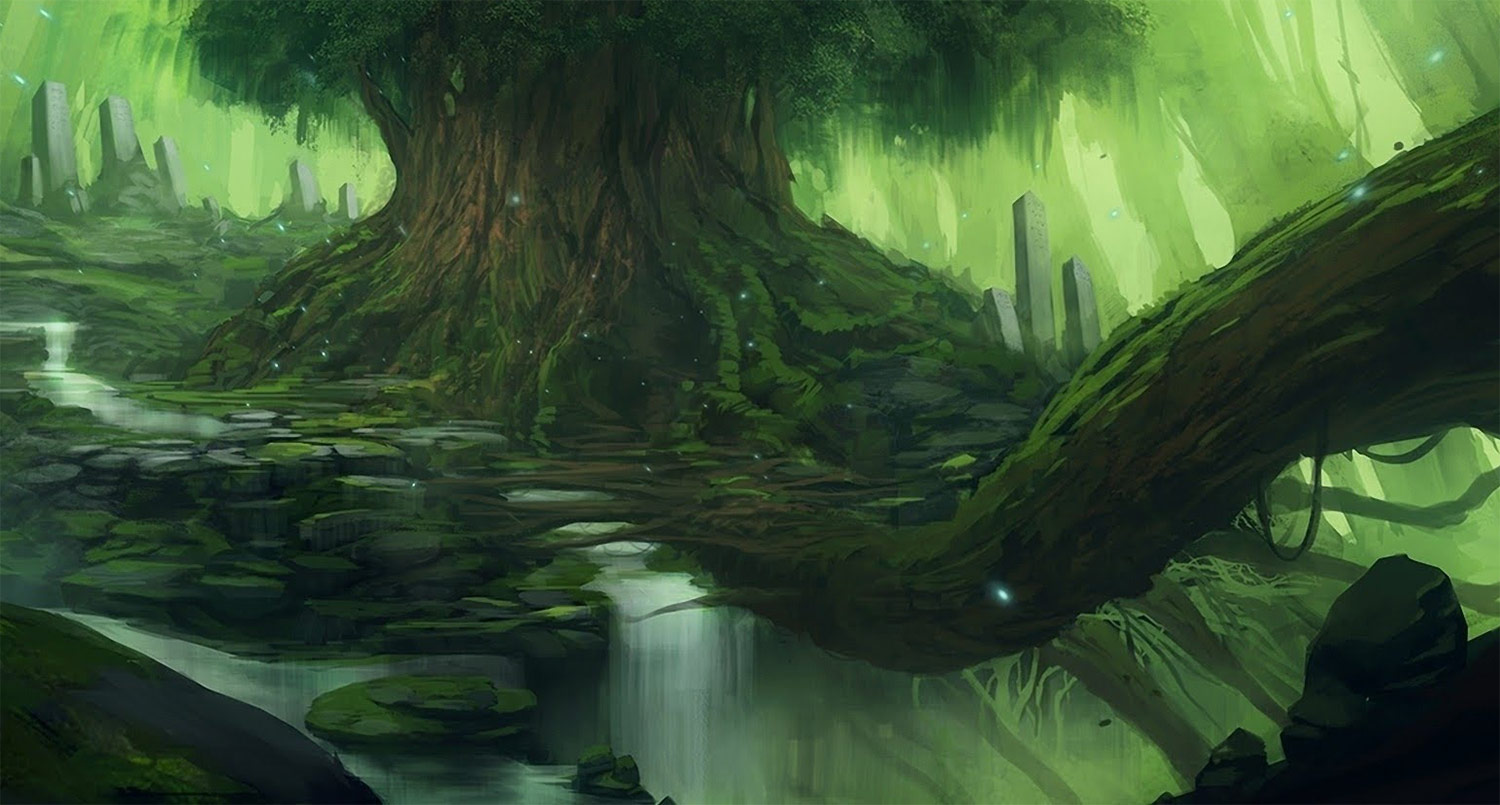
Flooded Roots
The Great Flood caused by the destruction of Solvheil expelled the Imlan Sea over the mountain basin that held it in. The waters washed over the surrounding lands causing catastrophic devastation, forever changing the landscape.
In the West, lowland portions of the Great Forest that had been near the mountain basin became what is now known as the Barl Swamp as the seawater found a new home.
The Hearleforne was not spared as floodwaters swept across The Great Forest and filled the recesses around its massive protruding roots. The seawater initially shocked the Hearleforne, and stunted foliage for a good number of seasons afterward until the mighty tree made a recovery.
The arcane library was located down among the roots, and much of the ancient tomes and scrolls that once filled its shelves deteriorated in the giant pool that remained. The power of the written word dissolved in a liquid had long been known to transfer magical properties.
This along with the power of various artifacts that once adorned or were kept safe in the library combined to make the waters volatile and magically unpredictable. Any arcane attempt to magically remove or cleanse the water fizzles at best.
It is said that what was taken by the floodwater is forever lost to the specters of the drowned souls who haunt the submerged roots. To this end, much of the knowledge of elven high magic had been erased.
Devastation caused by the folly of man had nearly cost Lyrith Elves everything, and it was an offense that would not soon be forgotten. Even after humans had been taken back to a more primitive form and lost nearly all memory of pre-flood civilization., the elves remember.
To the elves, this was the result of man not living in harmony with the natural world, and their arrogant quest to dominate while nearly destroying it in the process. Wiping themselves out would be one thing, but nearly taking the world could not be forgiven.
With the knowledge and beauty of the lower portions of the capital destroyed, the elves adapted Archonvale to focus on the upper portions of the city. A new temple to Ehllelo was errected up high among the branches, although she had been notably absent since the flood.
The magic infused waters below were mostly quarantined and avoided, as the dead and wild magic pockets it caused were deemed too dangerous.
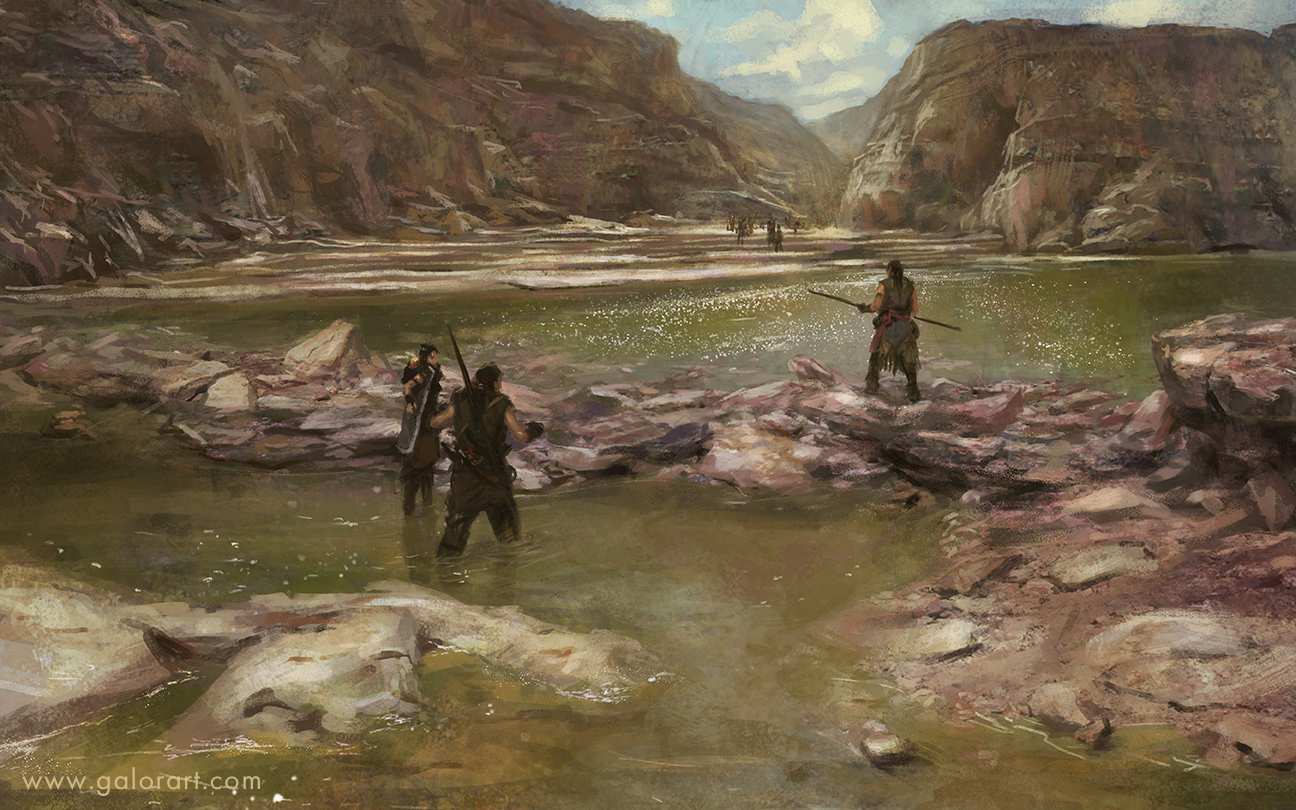
In Defense of the Forest
After the flood, scattered tribes of humans began to migrate to occupy the lands west of the mountains. Those who came from Kazatharis and Nalass particularly encroached on the lands occupied by The Great Forest.
As they sought a new home they relied on the natural resources of the area, especially timber, to fuel their migration. As the woods near the mountains has been transformed to marsh, the humans continued their movement further into The Great Forest, clearing trees and hunting for sustenance.
This put them in direct opposition to the Lyrith Elves who were sworn to protect the forest, and were already seething from the flood that had threatened to destroy the Hearleforne, their most holy of places.
Conflicts were instantaneous, as humans and elves were at odds from first sight. Having lost everything, the newly primal humans initially had no idea why they were subject to raids by these perceived savages, but did not hesitate to retaliate and escalate hostilities.
Camps begat settlements which in turn begat strongholds; the greatest weapon against the elves was human civilization. Dwarves, who had established a far more mutual relationship with man, often aided in expansion efforts. Even some smallfolk of the Waylands integrated into this new society.
After endless years of conflict, and significant losses to both elf and forest, some form of truce was needed. The Treeline Treaty, A compromise that was highly controversial in Archonvale and beyond, officially ended aggression between elf and man.
It stated that the majority remaining portion of The Great Forest was sovereign, officially recognized as an autonomous entity. Humans would refrain from further expansion or harvest beyond the agreed upon borders of Lyritholln, and Elves would respect the remaining lands as the kingdom of Dalreon.
While Lyritholln remained almost entirely surrounded by Dalreon, it forged a new alliance between the two, although a distant one that was not without isolated incidents. Elves never integrated into human society in any great number like others, but could now traverse their towns raising only passing suspicion.
Half-elfs, although rare, live probably the most isolated of existences, as they are never truly embraced by either culture. While they retain certain elven qualities, they have enough humanity in them to seem clumsy and unrefined in Archonvale. While their ears are normally a deal breaker for blending in completely among humans.
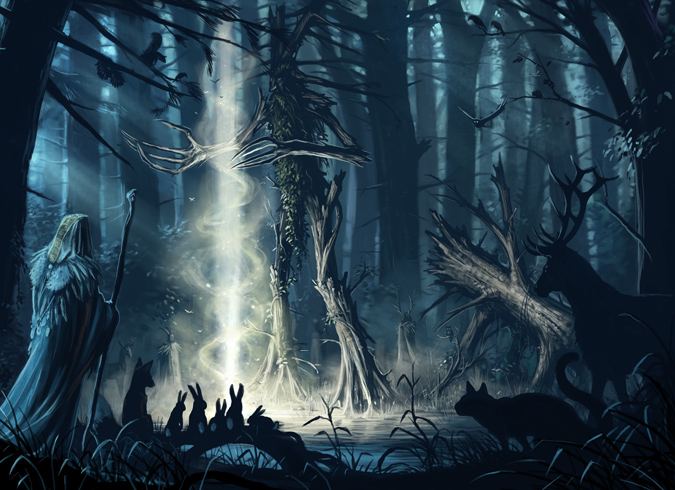
The New Nature
What was known as the natural world was partially remade by the flood. Landscapes altered, civilizations destroyed, and even magic and nature changed forever. The world that was, was simply no more. While the elements are still present in the material world, their binding to it seemed shifted.
Some elven scholars wonder if the ancient texts could be recovered from the flooded roots, would their incantations even apply anymore. Whatever caused the Imlan Sea to empty itself outward had changed much more than just the location of water, it had altered the fabric of reality itself.
Elves were not alone in their role as wardens of the new nature, as they were joined by Waylanders, Living Trees, Fey, and even some of their human neighbors. Druids and rangers from the human kingdoms began to serve along side in conservation.
Ehllelo, although not encountered since the flood, was surely pleased with this new alliance in her defense. Locations such as the Lorn Grove led by Forthryr the treant are places where druidic forces meet.
Possible Plot Hooks
- one
- two
- three
IV
Kingdom of Dalreon

Dalreon
The Kingdom of Dalreon [dal-ree-on] is loosely based on medieval Europe and ruled by a monarchy. It is the largest of the human kingdoms, and occupies the land West of the Crenmantle Mountains and South of the Barl Swamp.
The Royal Palace is located in the capital of Evertide along the Southeastern coast. Clerical healing and traditional sorcery are non-existent among the populous. Medicine relies heavily on herbal and alchemic methods.
- Ruler: King Jorlaan II
- Capital: Evertide
- Magic: Rare
- Rivers: Albrynn Fork, Fen River, Thynoth River
It's main trade routes to the Orilyn and the East are equally dangerous journeys. The first is across the Sea of Aluun which has claimed many a ship to its murky depths. The second is by caravan across the scorching Shalihir desert which holds countless perils.
Indigenous Races
Humans
The Kingdom of Dalreon is populated of mostly Humans whose ancestors were pioneers from Solvheil. They consider themselves more "civilized" then their neighbors to the North in Harrn. Dalreon also surrounds the Great Forest and the Elven kingdom of Lyritholln within it.
Waylanders
Beyond the Eastern edge of Lyritholln lies the Waylands. Small in stature, these folk are often underestimated when they travel beyond their home borders.
Towns and Settlements
The various population centers of Dalreon
- Evertide * (Capital)
- Albrynn
- Buskerdown
- Brambleston
- Falworn
- Gullyhaven
- Jerichons Point
- Midglade
- Ravenstead
- Rillisyn
- Rindleforde

Dalreon Army, the largest human fighting force in Elrithorn.
Albrynn
Albrynn is a hilltown in the kingdom of Dalreon aside Caneari Lake at the end of the Albrynn Fork off of the Thynoth River. The population is comprised of mainly terrace farmers and shepherds.
It shares a close proximity to Tahamman in Shalihir and is often used as a staging area for caravans headed for the desert.
Albrynn is home to one of the areas more popular drinks, the Albrynn Pale. A refreshing light ale that has earned praise from many a patron in taverns far beyond the Thirsty Tortoise tavern.
Places of Interest
- Thirsty Tortoise (tavern)
Proprietor: Paulis Asher- Bitter Leaf Apothecary
Proprietor: Remnar Kollan

Albrynn Map
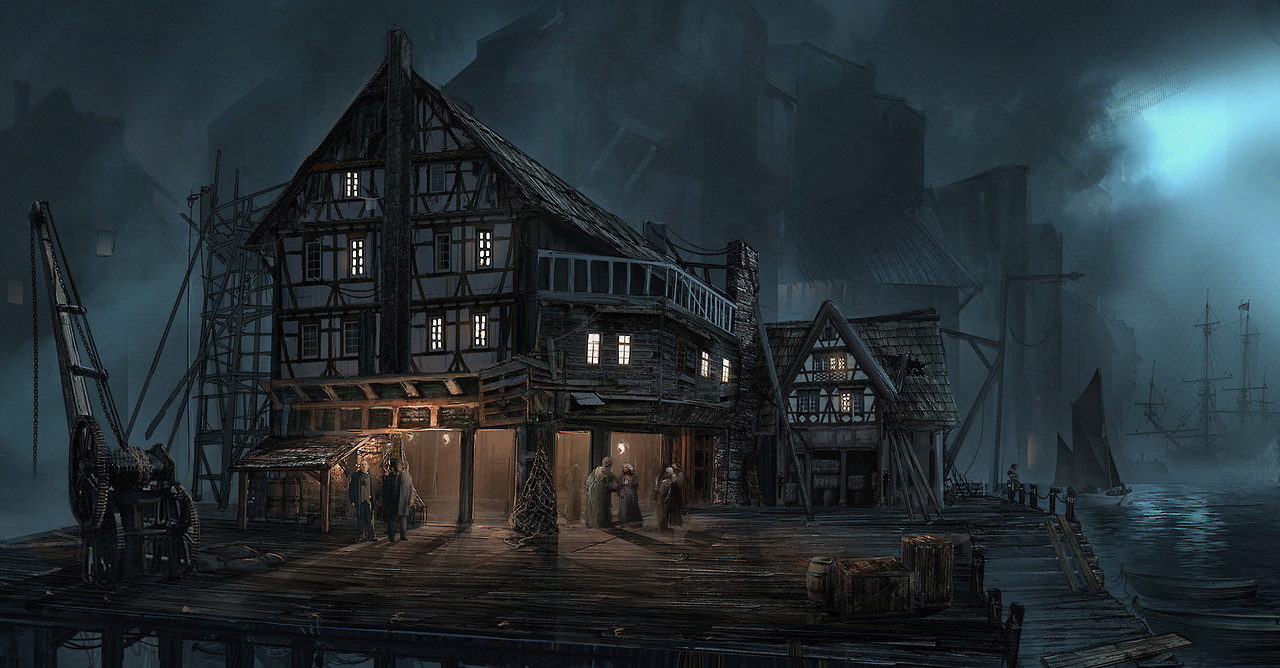
Evertide
Situated on the Southwestern edge of Dalreon where the Sea of Aluun meets the Thynoth River, Evertide is an impressive feat of human craftsmanship. The Crown Palace of Dalreon overlooks the sprawling districts and busy harbor below.
Playing more than just the role of capital for the Kingdom of Dalreon, Evertide also serves as the economic hub. Imports come in across the Sea of Aluun via Crown Port from the Orilyn Empire, while goods also arrive via caravan from the desert and get shipped downriver.
Evertide is home to several independent trading companies as well as the private houses of some nobility. Among some of the larger trade organization are the Ardent Anchor Trading Company and the Golden Gills Trading Company. These rivals both deal in the flow of goods across the Aluun Sea and economic diplomacy with the Orilyn.
It is also home to Dalreon's Ministry of Antiquities, who oversees any expeditions and excavations of discovered ruins or other finds of historical significance. They are often at odds with the Church of Tornne as to who has jurisdiction over artifacts and sacred relics.
The Crown College of Wizardry is a relatively new construction as the kingdom adapts to the reemergence of arcane magic.
Places of Interest
- The Crowded Net Inn
- The Shallow Skiff Inn
Proprietor: Yalen Noriss- The Salty Shark
Proprietor: Norral Gharman- Golden Gills Trading Company
Proprietor: Rellan Thec'lorakt- Ardent Anchor Trading Company
Proprietor: Ellisvar Onatell- The Marred Mariner Armory
Proprietor: Armond Nelth- Briny Shine Jewelers
Proprietor: Feldan Warlo- The Bountiful Barge Feasthall
Proprietor: Hurlay Cras- Coral Crown Brewery
The regional favorite, Coral Crown, is brewed here- Marells Mainstay
- Pithers Potions
Proprietor: Jordan Pither- Dyemaker
Proprietor: Gideon Banks

Evertide Map
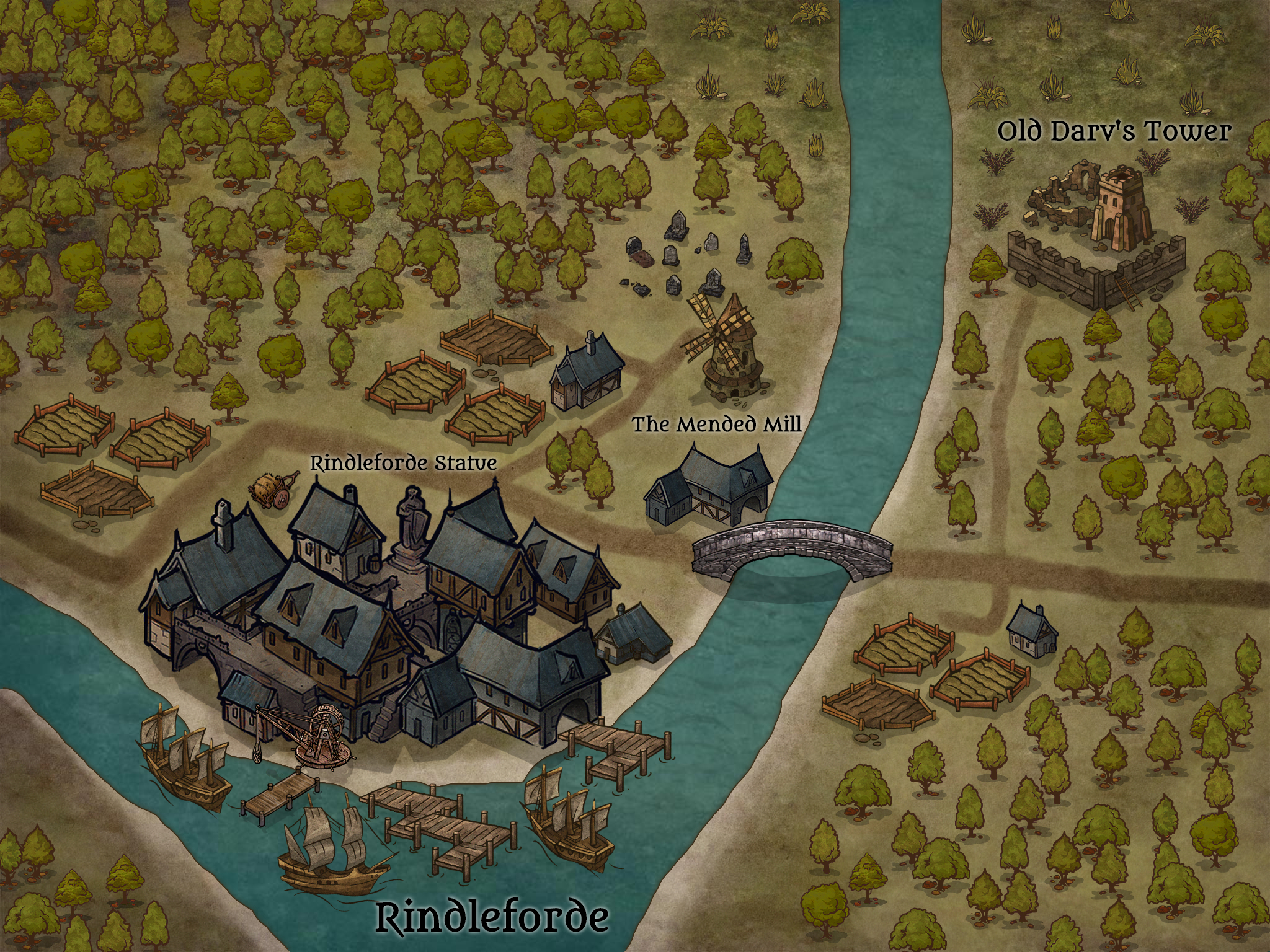
Rindleforde
Rivertown in the kingdom of Dalreon. Situated at the split of the Thynoth River, where the Fen River heads North toward the Barl Swamp, lies Rindleforde. This walled city is built around its impressive docks that server as the end of Dalreon's waterway.
Beyond this point on the Thynoth River lies the Great Forest and the kingdom of Lyritholln. Having been kept from developing any further into the forest by the elves, Rindleforde represents a sort of border between civilized land and the untamed wild.
History
In the early days of Dalreon when Evertide was little more than a fortified castle town, there was a nobleman of a merchant house named Ulrich Rindleforde. Ulrich had lost his two sons who were both members of a Crown force ambushed by orcs . Without an heir, Ulrich decided to spend the remainder of his days exploring the countryside.
It was on one such expedition into the forest that he came upon a fork in the Thynoth River. At this very spot he encountered an enormous brown bear catching fish along the bank. Being an avid hunter and spotting what was most certainly one of the largest specimen of bear ever seen, Ulrich retrieved an arrow from his quiver and nocked it.
The bear must have been no stranger to the workings of a bow and immediately charged the noble in effort to close the distance. Ulrich let loose his arrow and it plunged into the bear's shoulder without even slowing his stride. Seeing that another shot would be impossible, Ulrich unsheathed his dagger and met the bear head-on to engage in close range combat.
Ulrich Rindleforde finally bested the bear at the cost of his own life. He was beyond saving by his hunting companions as he had lost too much blood and suffered grave injuries. With his final breaths he crawled upon a nearby hilltop and died.
His body was laid to rest where it had fallen and the Crown established decreed that the settlement built around it would be named in his honor. Having no legitimate heir and effectively taking the name Rindleforde with him, the town was meant to stand as a testament to his legacy and to man's accomplishments over his environment.
The new town began with a citadel to act as a stronghold. Since Ulrich was buried upon the largest hill, the citadel was constructed directly next to it breaking with tradition of placement on the highest ground. During the construction of the town, many ruined foundations were discovered as well as evidence that whatever structures once occupied the area were razed.
One of the most impressive of said foundations was the remains of a watermill that adjoined the Eastern fork. Documents and tablets recovered there identify it as the Marathorl Mill which corresponded to local legend of a lost settlement of man's migration after the flood. New brick and mortar went atop this foundation as the Mended Mill became one of the first and largest structures of the town.

Rindleforde Map
Places of Interest
- The Splintered Stern Inn
Proprietor: Willum Thraw- Surenock's Bowyer
Proprietor: Quinlan Surenock- Bargle Tannery
Proprietor: Keris Bargle- Mended Mill
Proprietor: Fordwin Miller- Silverten Stables
Proprietor: Jaren Pallus- Thellim's Tailor
Proprietor: Osgood Thellim- Thynoth Dockhouse
Proprietor: Verron Carllon
- Powderstone Bakery
Proprietor: Samuel Powderstone- Steelhand Smithy
Proprietor: Trom Steelhand- Sturdystone Warehouse
Proprietor: Tholn Sturdystone- Tangleroot Apothecary
Proprietor: Folian Tangleroot- The Oaken Barrel
Proprietor: Teric Cooper- Waterfork Brewery
Proprietor: Filnertav Lawral
Crown Port
The sea of Aluun is the southern barrier that separates the East from the West, with the Isle of Sampeatos [sam-pee-tōs] in the center. Within it it's rocky shores are ruins from an ancient sampeatan civilization, now overgrown and treacherous.
It is largely unpopulated by any kingdom. The approach to Sampeatos is difficult due to the many rocks and coves. This makes it a favored haven for pirates of Eraemos Archipelago who prey on merchant ships between Orilyn and Dalreon.
It is also home to many strange beasts within its depths that aren't found on the mainland. The island is home to several strange species of flora and fauna not found anywhere else. Several expeditions have been attempted to retrieve specimens of the great beasts that inhabit there. Few are met with any success.
While an overwhelming majority of the area is unsettled and dangerous, there is one stable hub of civilization on the island.
Crown Port is a trade jewel among the treacherous terrain of the Isle of Sampeatos and the Sea of Aluun, The city is a major port for trade between kingdoms as it lies on a major trade-route between Dalreon and Orilyn.
Dalreon keeps control of Crown Port as a center of power in the chaotic waters of the Sea of Aluun. While all official commands come from Evertide, Crown Port sways to the many winds of the water.
Cargo ships from Dalreon, Orilyn, and Korlondor often use Crown Port as a halfway point in their voyage, making it a lively and eclectic port on the savage island. It also happens to be one of the most notorious locations for pirates, smugglers, and all manner of nefarious intentions.


Law and criminality are constantly at odds in Crown Port.
Places of Interest
- The Parched Parrot Tavern
- Location
*Proprietor: *- Location
*Proprietor: *- Location
*Proprietor: *
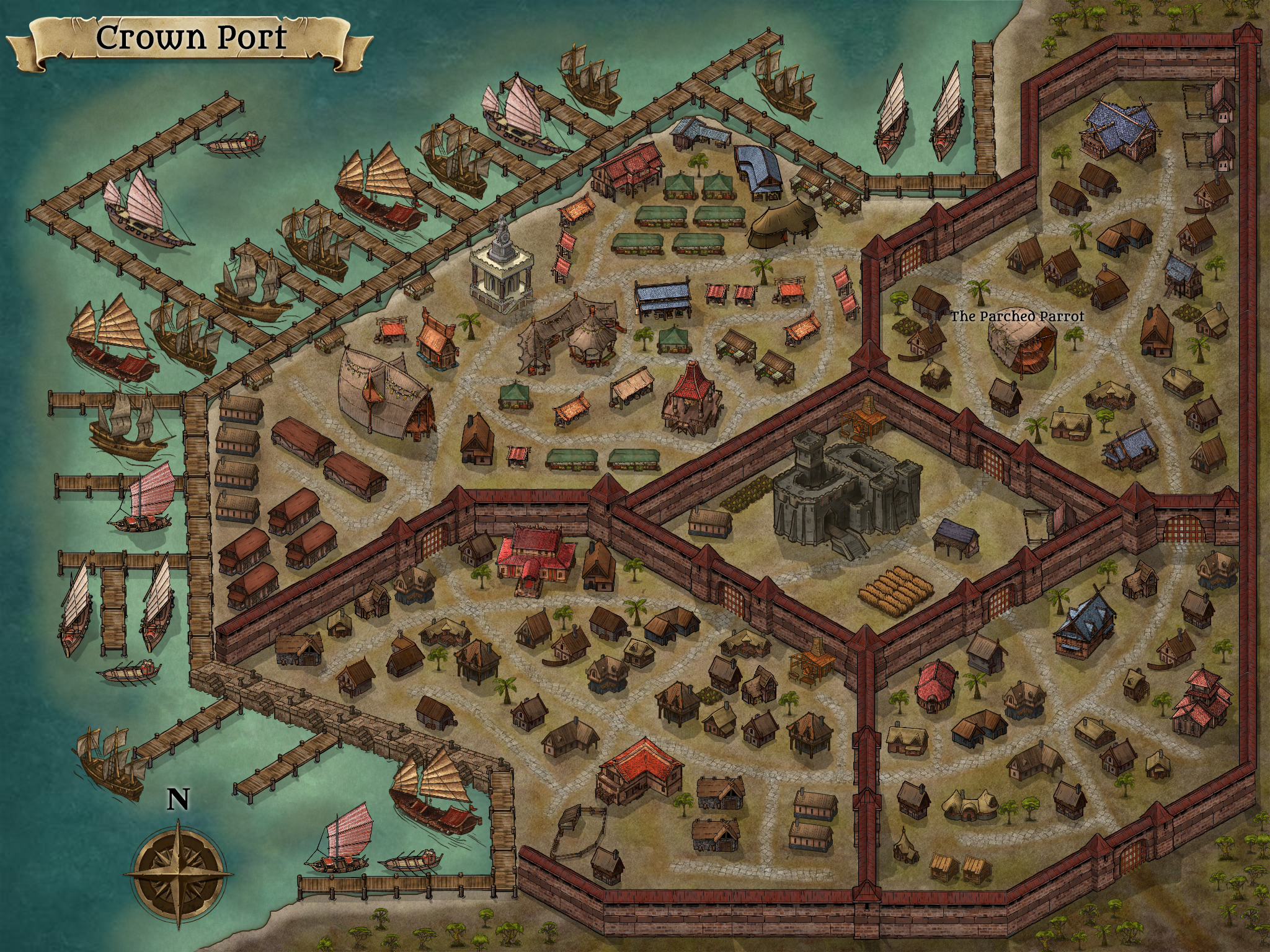
Crown Port Map
V
Empire of Orilyn

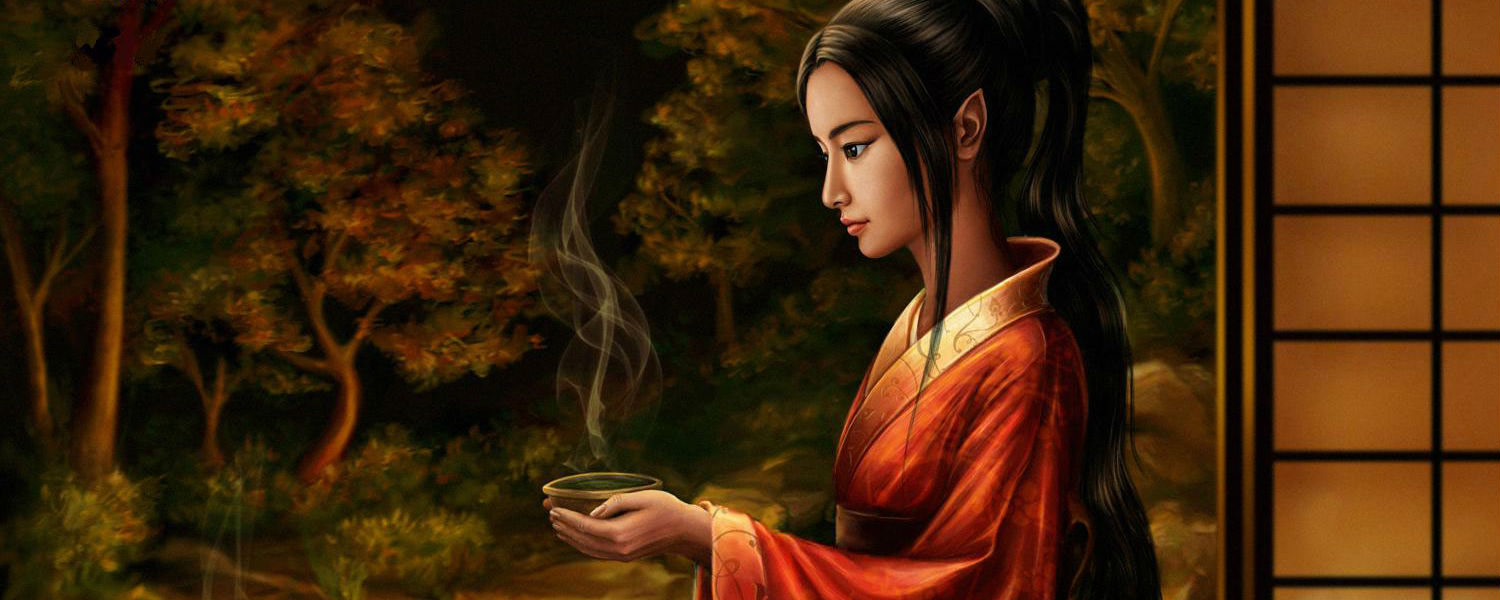
The East
Orilyn is as far East as one can travel and still be in mostly inhabited land. The Empire known as Orilyn [ohr-uh-lin] is loosely based on Feudal Eastern Asia.
- Ruler: Emperor Xan
- Capital: Hu Taar
- Magic: Uncommon
- Rivers: Yral River
The Land
The topology varies between extremely craggy mountain ranges, dense forests, and marsh lowlands.
Orilyn begins at the Jadestone Gate of the Shalihir Desert which cuts a path in the bordering Manticore Mountains. Orilyn then extends South as a narrow landmass with its Northern border marked by the Chul Savanna, and the Zhanthul Jungle bordering the East.
The Southmost point shares a border with Korlondor and the Eraemos Archipelago and the West is met by the Sea of Aluun.
The scars of the ancient flood are marked by wet lowlands and swampy marshes, while mist-filled forests and grasslands occupy the high ground. Rice is the chief agricultural product simply by the nature of the farmable land.
Smaller mountain ranges form natural borders between regions with the highest peak, Mount Dramoto, holding significant religious symbolism as it is said to be the home of the Golden Dragon.
Indigenous Races
Orilyn Named the same as the land, the Orilyn are a very spiritual culture that places a high priority on honor and pride above tangible reward. The populace of Orilyn has unique physical features that distinguishes them from inhabitants of the West and the desert.
They have slightly tilted eyes and an amber tint to their skin as well as slightly pointed ears. They are generally sleek and agile and among the most skilled of melee fighters
Aarakocra Bird-like humanoids who inhabit the peaks of Southern Orilyn as well as the Eraemos Archipelago, where they are directly opposed to the Yuan-Ti.
Monkey Lords Humanoid simians from the Zhanthul Jungle who once ruled over Orilyn.
Ogre Magi Dangerous spell-casting version of the western ogre found in Orilyn.
Zinyari Powerful assassins that employ innate shadow magic in direct opposition to both Orilyn and the Sabaril.
Towns and Settlements
The various population centers of Orilyn
- Hu Tarr * (capital)
- Shi Noo
- Tigeran
- Shun Rii
- Najoryn
- Sojoryn
- Ghen
- Shao Lo
The Four Dynasties
History is marked by four distinct periods that start with the invasion of the Monkey Lords which put the populace under their rule. Each shift in power from that point onward marks a new dynasty.
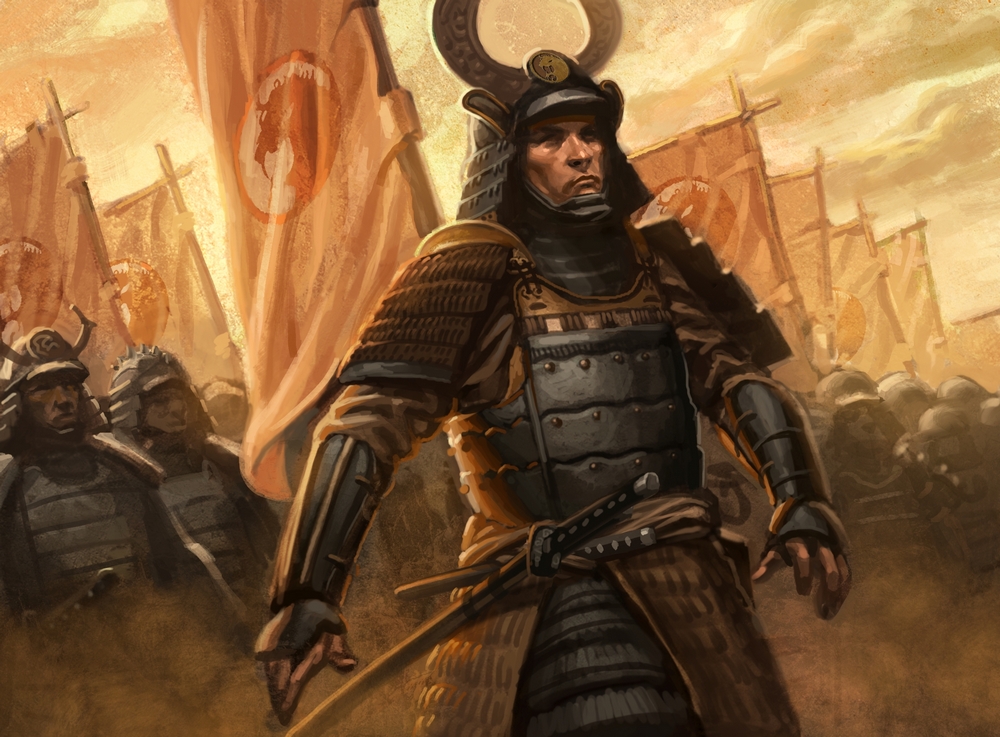
Monkey Dynasty
When the Monkey Lords traveled West from the Zhanthul Jungle, they conquered most of what was Orilyn quickly disarming the people and removing any claim to land. After they had sufficiently brought the populace under their rule, they began work on a capital on a island offshoot West of the mainland.
Hu Taar was constructed as a sprawling stone complex with many of the architectural styling found in ruins of the Zhanthul Jungle.
It was during this time that the Seven Masters took a group to the Zhanthul Jungle where the Monkey Lords had come in search of a way to defeat them. Returning with secrets revealed to them in the wild, their forces overwhelmed the Monkey Lords with unarmed fighting styles modeled after the animals they had observed.
Tiger Dynasty
Emerging as the most fearsome warrior of the Seven Masters in the defeat of the Monkey Lords, the Tiger assumed the rule of Orilyn as its first Emperor.
During this rule, Hu Taar was expanded vertically on top of the previous structures to include more ornate and angular design reflective of the ferocity of the Tiger style. The architectural shift was meant to visually solidify the end of the Monkey Dynasty, and build atop the foundation in the emerged Orilyn style.
Availability and practice of weaponry became more prevalent among the people as they vowed to never again fall prey to exterior threats. The use of seemingly mundane farming instruments as extremely effective weapons grew in popularity, as did the training of one's self as a weapon.
With the defeat of the Monkey Lords, an eighth fighting style was added adopting some of their natural technique.
The Tiger Dynasty ended when one of the Tiger's decedents was tricked by an evil spirit with a tigers head into taking a cursed blade to his hand and falling to the seduction of the Demon Lords which ushered in the Demon Dynasty.
Demon Dynasty
Tricked by a rakshasa, the great grandson of the Tiger fell to the seduction of a cursed blade and Hu Taar and the rest of Orilyn quickly fell to rule of the Demon Lords. During this time, the Zinyari revealed themselves en mass.
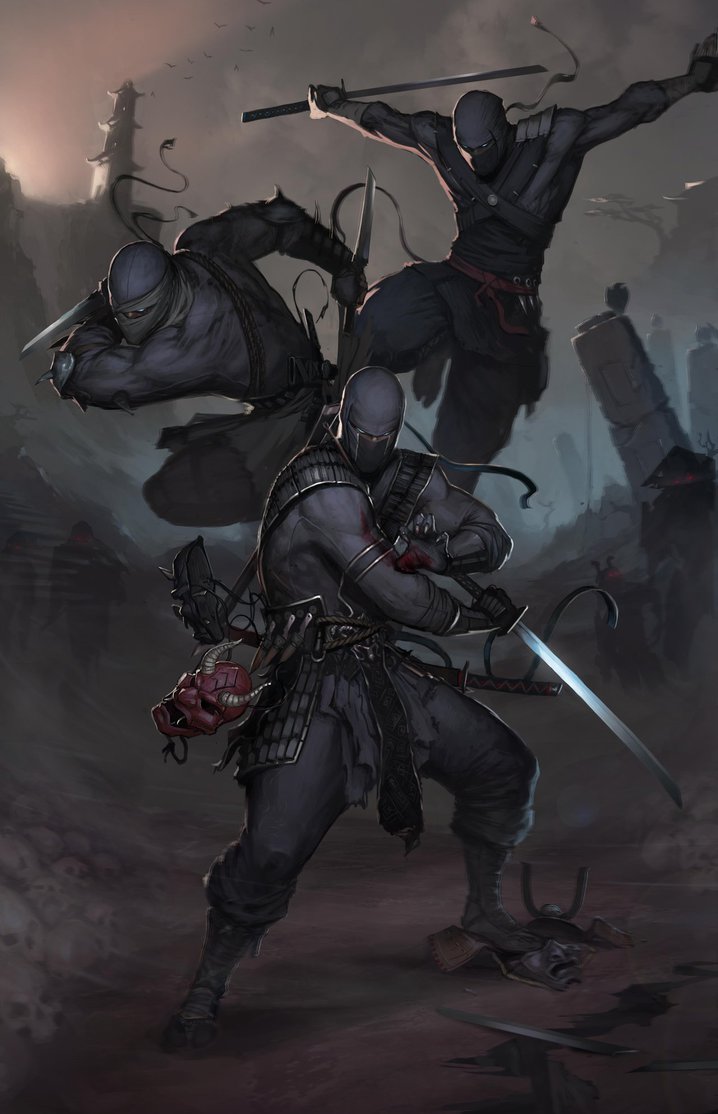
This Dynasty ended with the beginning of the Dragon Dynasty, when the Ninth Master emerged to defeat the Demon Lords and take his place as Emperor of Orilyn through the help of the Golden Dragon.
Dragon Dynasty
The Ninth Master defeated the Demon Lords using the Dragon style brought back from Mount Dramoto.
Monkey Lords
Humanoid simians who once ruled over Orilyn, the Monkey Lords took the weapons and subjugated the early Orilyn and forced them to build Hu Taar as a stronghold. They were defeated by the Tiger and the other six of the Seven Masters who returned from the Zhanthul Jungle with new fighting styles that defeated the Monkey Lords even without martial weapons.
Their influence can still be seen in the lower portions of Hu Taar as it sits upon the original foundation of stone. There are also still quite a few left around Orilyn, and are still referred to as Monkey Lords, despite their low status, out of respect of their former rule.
Seven Masters
In the time when the Monkey Lords ruled over Orilyn, Seven Masters returned from their escape into the Zhanthul Jungle to bring a new unarmed fighting style to the subjugated people.
Styled after various beasts in the wild, these new styles spread among the Orilyn, and quickly dispatched the Monkey Lords who had relied solely on the absence of weapons. This would mark the end of the Monkey Dynasty and the beginning of the Tiger Dynasty.
First Emperor
The Tiger, first Emperor of Orilyn, was in fact a weretiger who contracted lycanthropy in the Zhanthul Jungle during the exile under the Monkey Lords. Stories of him taking the form of a man tiger are accurate, as he would often shift to enhance the effectiveness of his fighting style since the Tiger Form is even more deadly with actual claws.
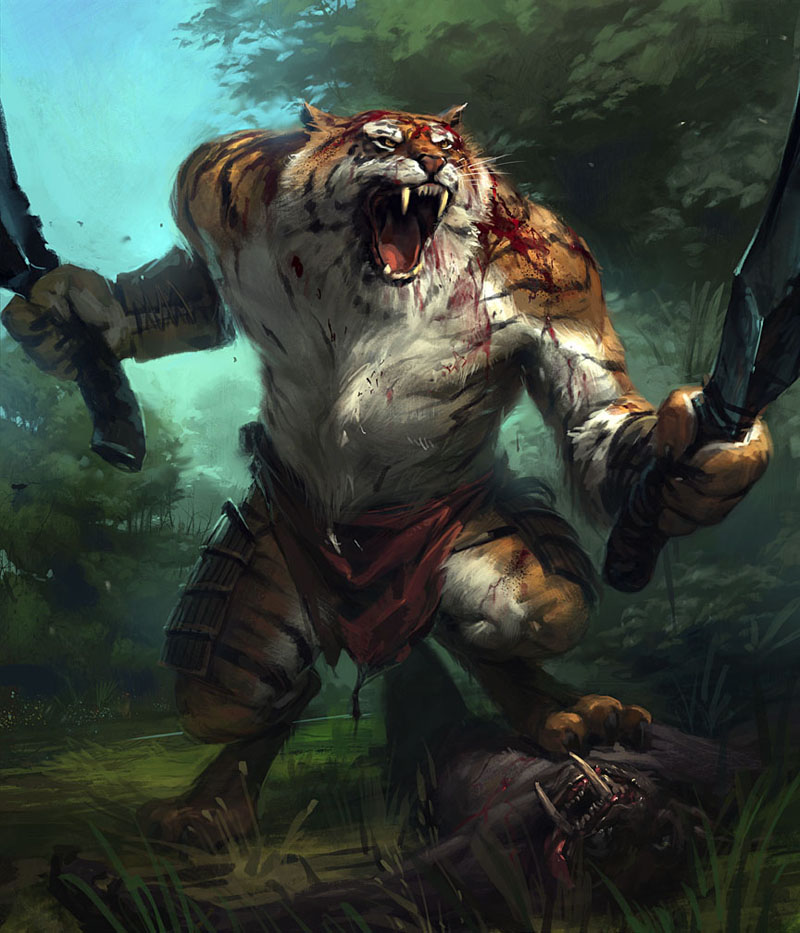
The Seven Masters were led by the Tiger, who exhibited the fiercest fighting style and most effective against the Monkey Lords, and was also able to take the partial physical form of the beast while in combat.
Styles of the Seven Masters
- Tiger
- Snake
- Crane
- Leopard
- Boar
- Eagle
- Mantis
Added Later
- Monkey
- Dragon
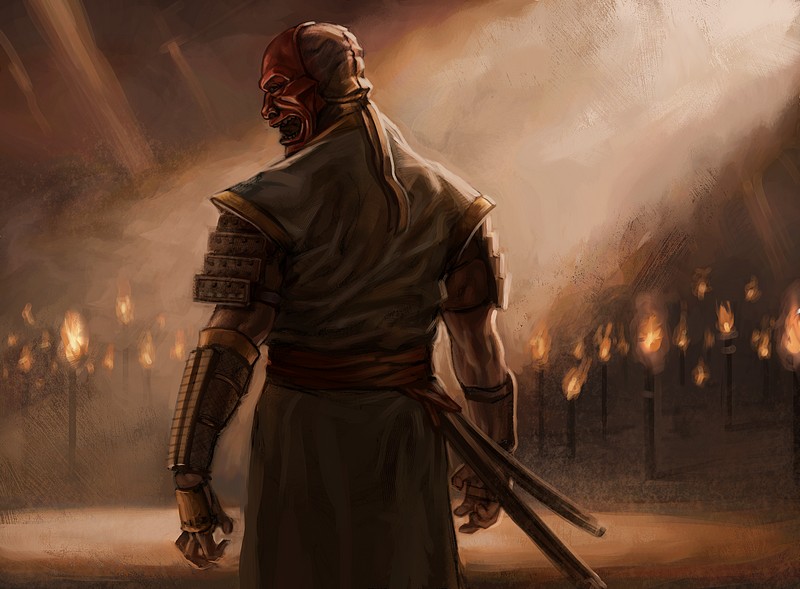
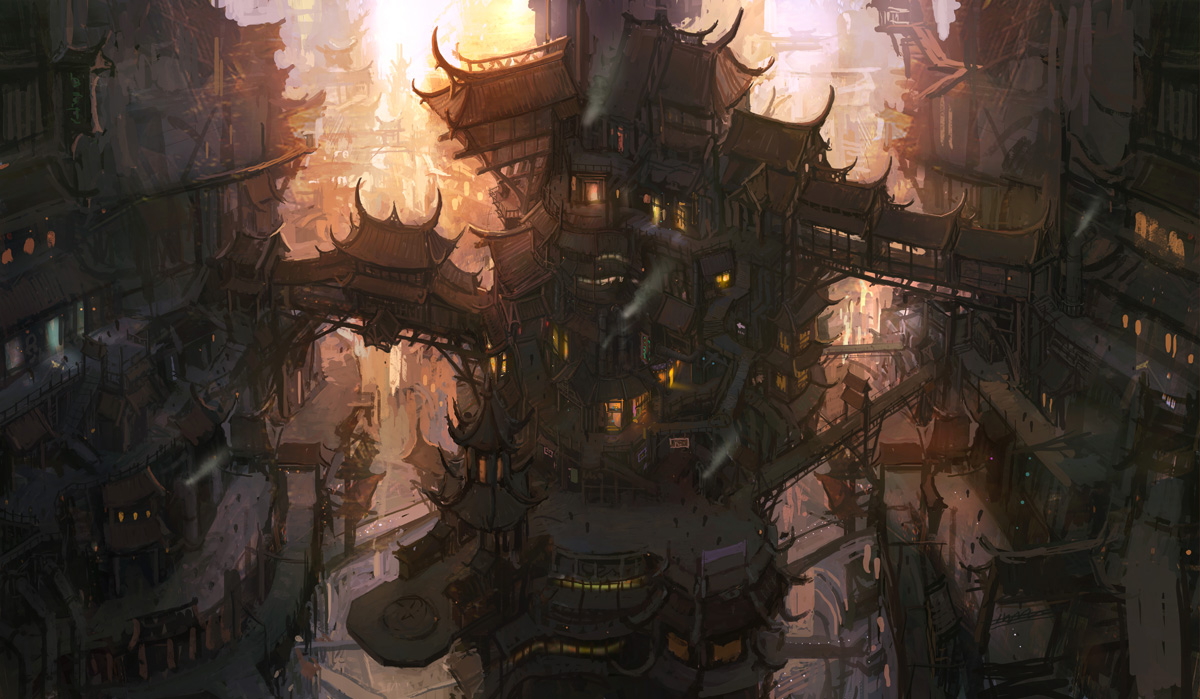
Hu Taar
The capital is a city that had grown toward the clouds, because that was the only direction available. When the Monkey Lords ruled, they forced Orilyn to construct a stone fortress for them on the island, which now serves as the city’s foundation. As with any good fortress, it was designed to take up as much as the available real estate as possible.
After the Seven Masters returned and the defeated the Monkey Lords, the Tiger, first emperor of Orilyn, built upon that stone a new city.
The Tiger Dynasty marked Hu Taar with a distinct architectural style that matched it ferocity with sharp edges, and hard angles; a stark contrast to the smooth and slightly rounded quarry block form of the initial construction.
Both dynasties to follow came with their own additions to the city, constantly pushing the rooftops to even greater heights. Unlike other cities in Elrithorn, Hu Taar forced one to think in three planes when navigating. Finding the right meeting of two paths may not necessarily put you any closer to your destination if it was three levels above.
Looking from below, it wasn’t hard to fathom the Orilyn having elven blood. The spires and columns of Hu Taar stretched up like so many sturdy trunks. Walkways stretched between platforms. Structures so tightly integrated, one wondered where one ended to begin another.
The only real easy distinctions were the four dynasties stacked on upon the other. Each one a visual reflection of a period of history, like rings on a tree.

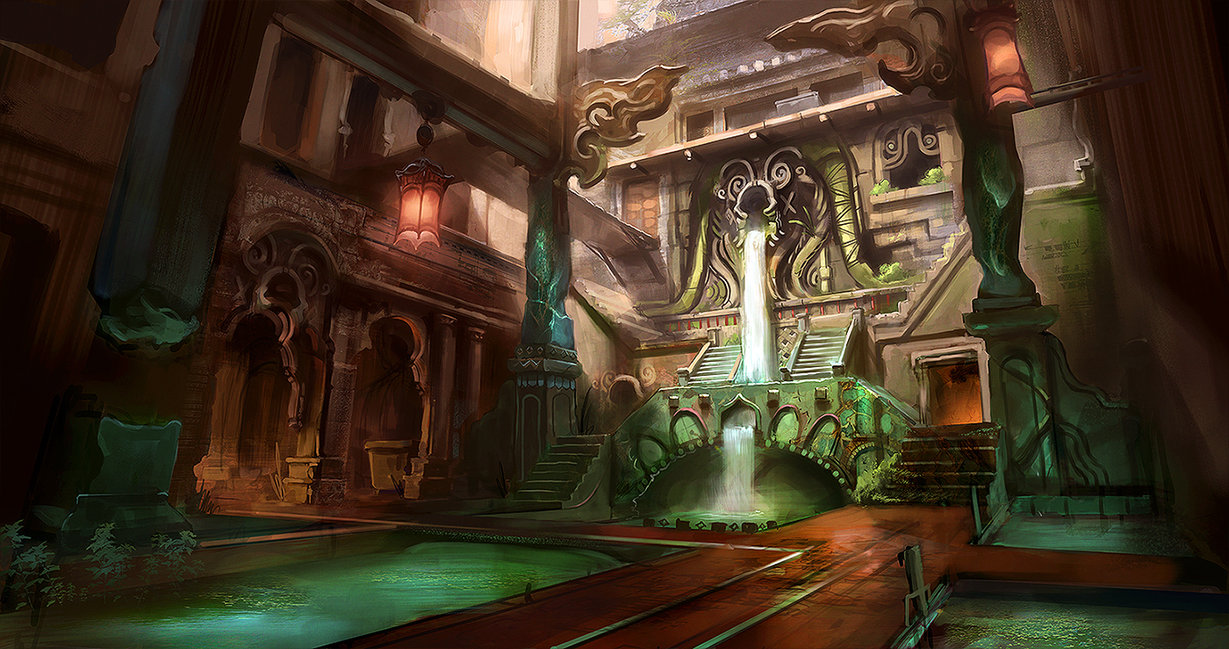
Places of Interest
- Imperial Palace
- Orchid Petal Alchemy
Proprietor: Yoshanii Musanomo- The Stilted Crane Inn
Proprietor: Kyr Shinataa- Golden Leaf Armory
Proprietor: Taiga Lu
Magic in Orilyn
Some can cast arcane spells without having to study them beforehand by pure will. They attribute this to the blood of the Golden Dragon that still courses through their veins generations later, which also gives their skin its faint golden hue.
In this way their draconic heritage allows for what some call "Fire without parchment" which means spellcasting without preparation or scroll. While natural sorcery exists in other regions, it is more common in Orilyn.

The Imperial Palace of Orilyn in the capital of Hu Taar is protected by the Sabaril Warriors. Sabaril are master swordsmen trained from a very early age and the sworn protectors of the Empire. They possess a unique mastery of their physical body and exhibit a telekinetic ability to exert force at will.
While this may not be magic in the strict sense, it is an extraordinary feat that is only present in Sabaril after years of training. It is said that this was brought down from the Golden Dragon by the Ninth Master.

Najoryn Map
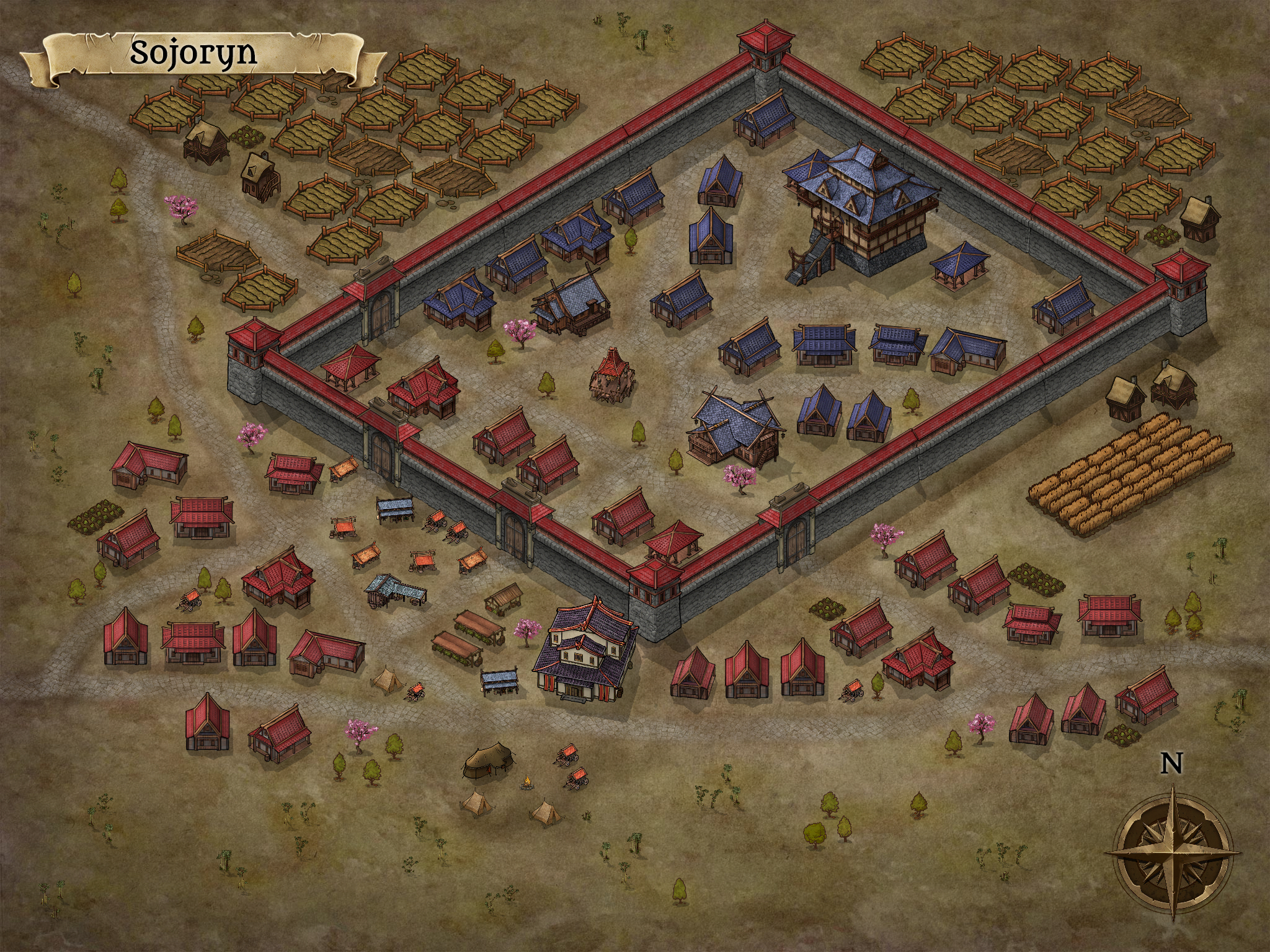
Sojoryn Map
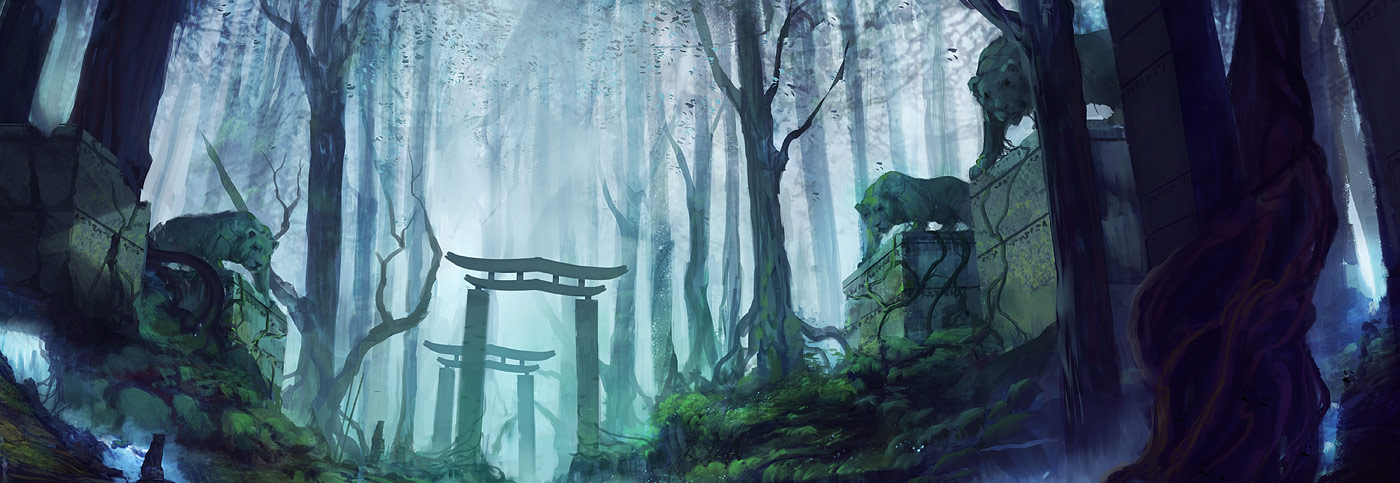
Differing Views
Orilyn Parable
Long ago, in an Orilyn temple, a master instructs his young students, "A retired warrior spends the second half of his life on a farm he acquired. Having only two sons separated by a year in age, he decides how best to divide his estate between them. To his firstborn he leaves the farm, the finance, the land, the buildings, and all of the other worldly possessions. To his youngest, he leaves only his sword. In which son did he put the most faith?"
The students sat a few moments in contemplative silence until one spoke up, "Master, he entrusted all of his wealth to the oldest. In that son he has clearly placed the most responsibility, and trust."
"Of course you must be right," the master responded, "for he did will all he had to the eldest, save for the blade."
"Master wait," another student interjected, "for he had given the youngest son that which he used to build his empire, while only leaving what he himself had acquired to the firstborn." The master listened as the student continued, "He had clearly put more faith in the youngest son, for he willed only the means to do what he himself had done."
"Yes my astute pupil," the master explained, "He had given the firstborn the birthright, entrusting him to continue the legacy that he would leave behind. However, what he had given the younger son was the chance to do better, should he keep his resolve as sharp as the inherited blade."
"But Master," another asked, "what if the second son takes up arms against the first?"
"Then both are lost," the master answered.
Local Saying
"A leopard cannot change its spots, but if it can change the rest of its fur to match it becomes a panther."
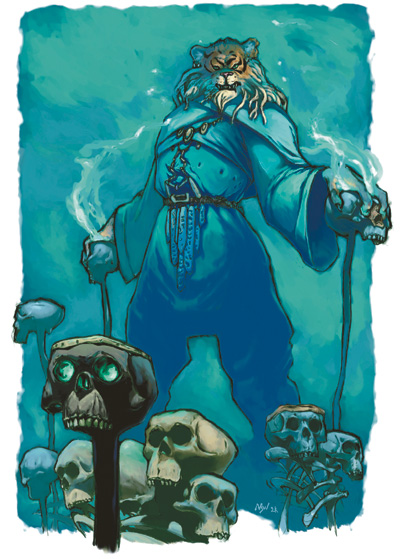
Lycanthropy is not viewed as a curse of affliction as it is in the West. It is instead looked upon as a blessing and burden of great responsibility, as the first Emperor was a weretiger, and it is suspected several other of the Seven Masters shared more than the fighting style with their animal.
It was this very respect for both ancestry and shapechangers that led the great-grandson of the Tiger to be led astray by a manipulative Rakshasa who posing as the spirit of the first Emperor.
VI
Harrn
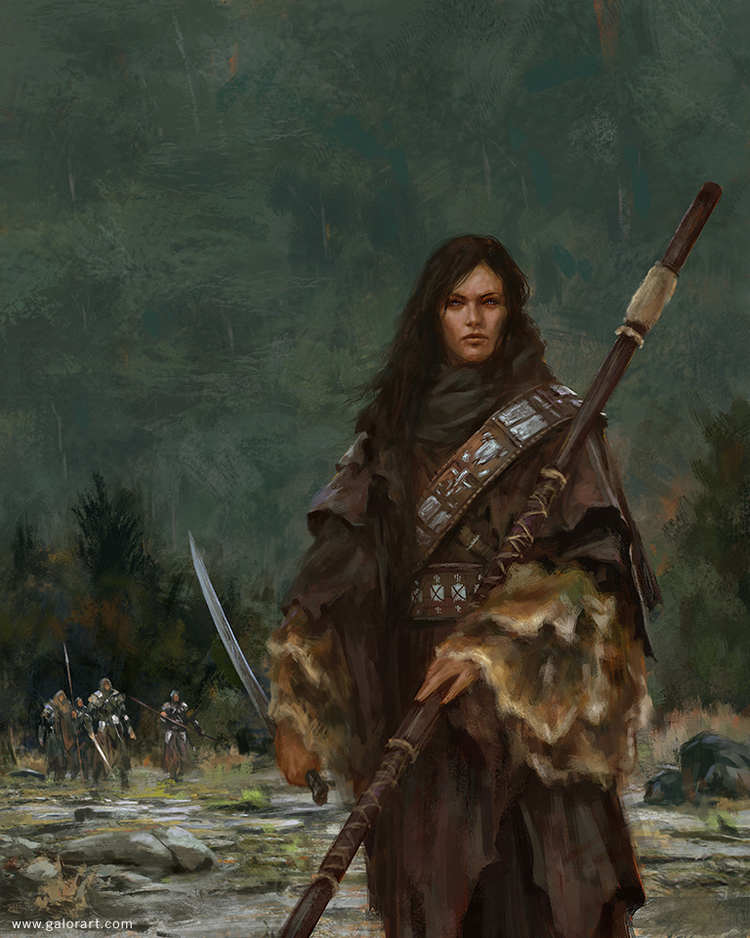
Harrn
The Kingdom of Harrn [hahrn] is loosely based on Europe's old Germanic culture and is ruled as a monarchy. The Proud Kingdom, the average Harrn is larger than a Dalreon man. Their skin is thicker and better suited for the colder winters.
A majority of them make their living as ranchers or fishermen on the sprawling countryside. It is said the plains of Harrn are of the richest in game as can be found anywhere, the North's answer to the Great Forest.
- Ruler: King Ulivon
- Capital: Jarldorf
- Magic: Rare
- Rivers: Jarlforf River, Stonegullet River
Harrn also has ready access to the mountainous kingdom of the dwarves and the resources from deep within. The trade of gems as currency is common and ore is never in short supply. Timber isn't as plentiful as in Dalreon so the Harrn make use of the Shivering Pines Forest across the bay.
Religion in Harrn is primarily based around the elements and their respective gods in which they share a kinship with the dwarves who worship Pulanthor. Trade exists between Harrn and the dwarven kingdoms as they both remain isolated to the rest.
Indigenous Races
Humans
Taller than those found in Dalreon to the South, the human inhabitants of Harrn are of sturdy build, large stature, and thick skin. Although also descended from Kazatharis, as well as Nalass, they have gradually adapted to the harsh northern environment.
Dwarves
The Dwarves maintain a large clan structure and inhabit the Stoneclef Mountains that borders the North of Harrn. Their religion centers around Pulanthor, God of the Earthen Element. This drives them to mine their homes deep within the rocky crags of the mountains
Dwarven magic is runic and operates on the principle of power being executed by the spoken word and stored by the written. They are also capable of some minor forms of gemcasting, and have an ample supply of precious minerals.

Towns and Settlements
The various population centers of Harrn
- Jarldorf * (Capital)
- Coldstag
- Gronith
- Khalinmoor
- Storneth

Jarldorf
Places of Interest
- Hollenfund Tavern
Proprietor: Nelanora Panznal- The Rusty Hook Fishery
- The Sterling Stein Tavern
Coldstag
Coldstag is a village in Harrn just East of Jarldorf. It is the last settlement before the Shivering Pines Forest and Lontharvia.
Khalinmoor
Khalinmoor is a town in Harrn that holds one of the crossings of the Jarldorf River, with the other being to the Northeast in Jarldorf itself.
Storneth
Hilltop town at the base of the Stoneclef Mountains.
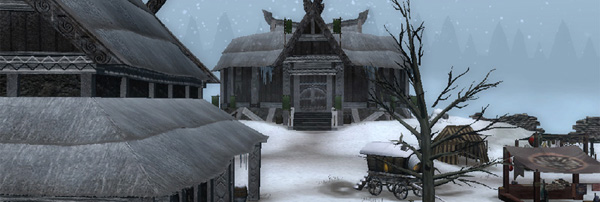
Places of Interest
- The Titans Tankard
Proprietor: Krythes Hounass- The Mangled Mane Inn
Proprietor: Zarneh Ossignet- The Inked Blade
Proprietor: Balenog
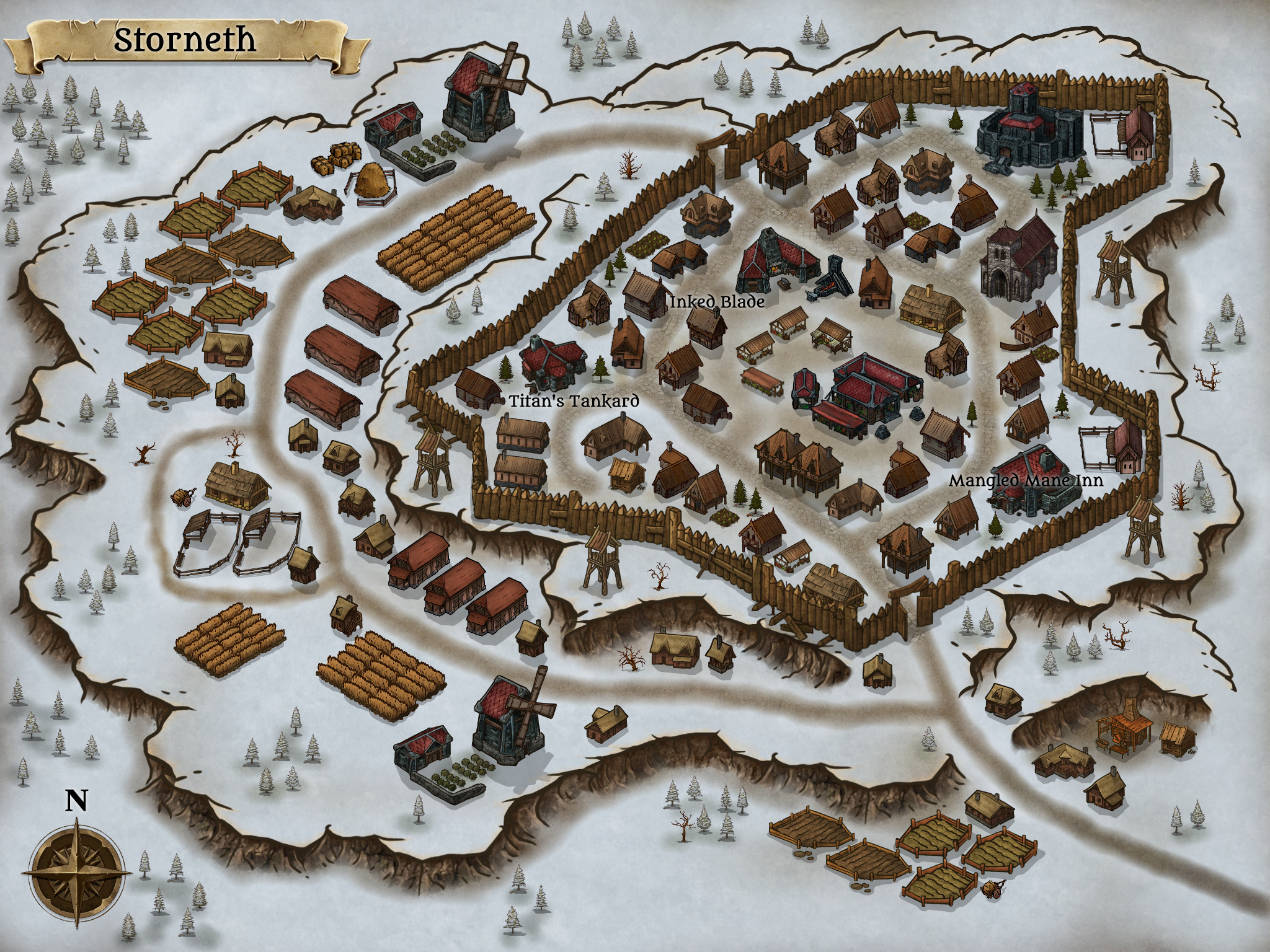
Storneth Map
VII
Beyond the Shivering Pines

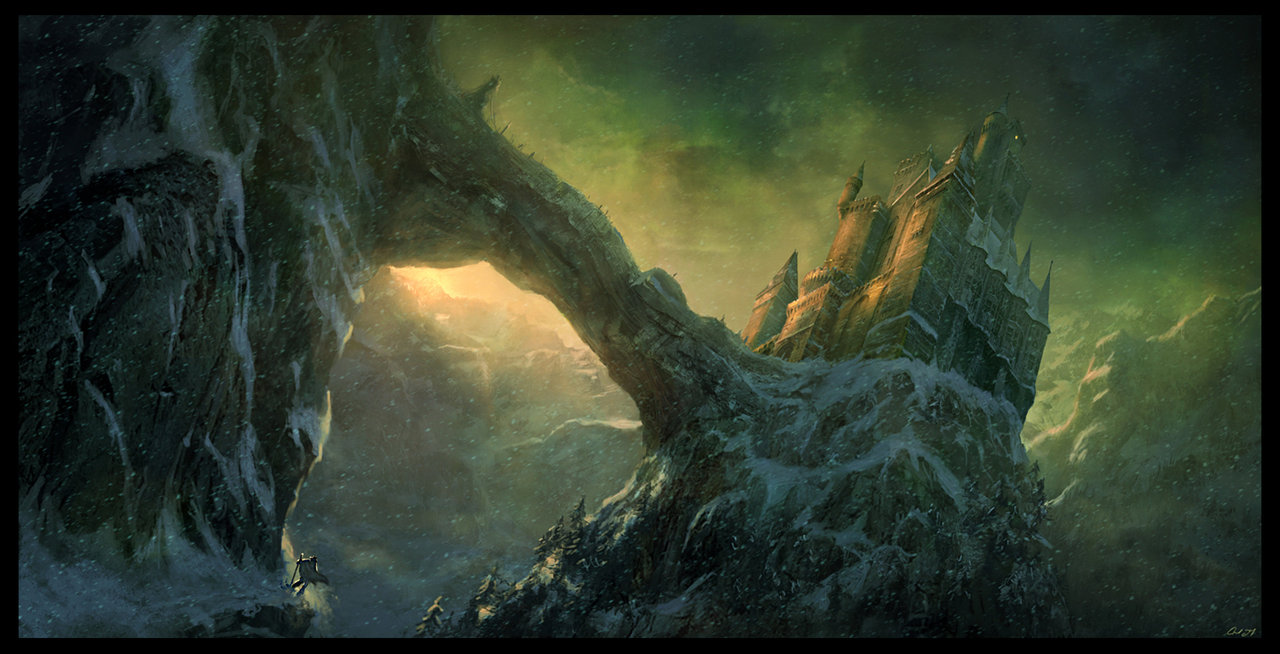
Lontharvia
beyond the Shivering Pines Forest in the far reaches of Harrn lies the small region known as Lontharvia. The area is a boreal forest with long winters, short summers, and dominated by needleleaf trees and treacherous wildlife.
It is ruled by Baron Dra'ithkyrn from his castle in the Caspez Peaks. The territory was claimed by the Baron's ancestor, a Nalassian prince, long ago before the flood.
King Ulivon maintains the long tradition of allowing Lontharvia to operate nearly autonomous from the crown of Harrn in Jarldorf.
- Ruler: Baron Dra'ithkyrn
- Capital: Spinehollow
- Magic: Uncommon
Because of this, the Baron has been able to continue the enforcement of Lontharvia's embargo on silver as he suffers from the same allergy to the metal as the rest of his bloodline.
All persons and wagons entering Lontharvia are subject to search and forfeiture of any silver weapons, items, or jewelery. Equal value of other denominations are issued for those wishing to exchange silver coinage.
The Baron makes infrequent public appearances often wandering no farther than Spinehollow, and rules Lontharvia from Castle Dra'ithkyrn that towers over the village below.
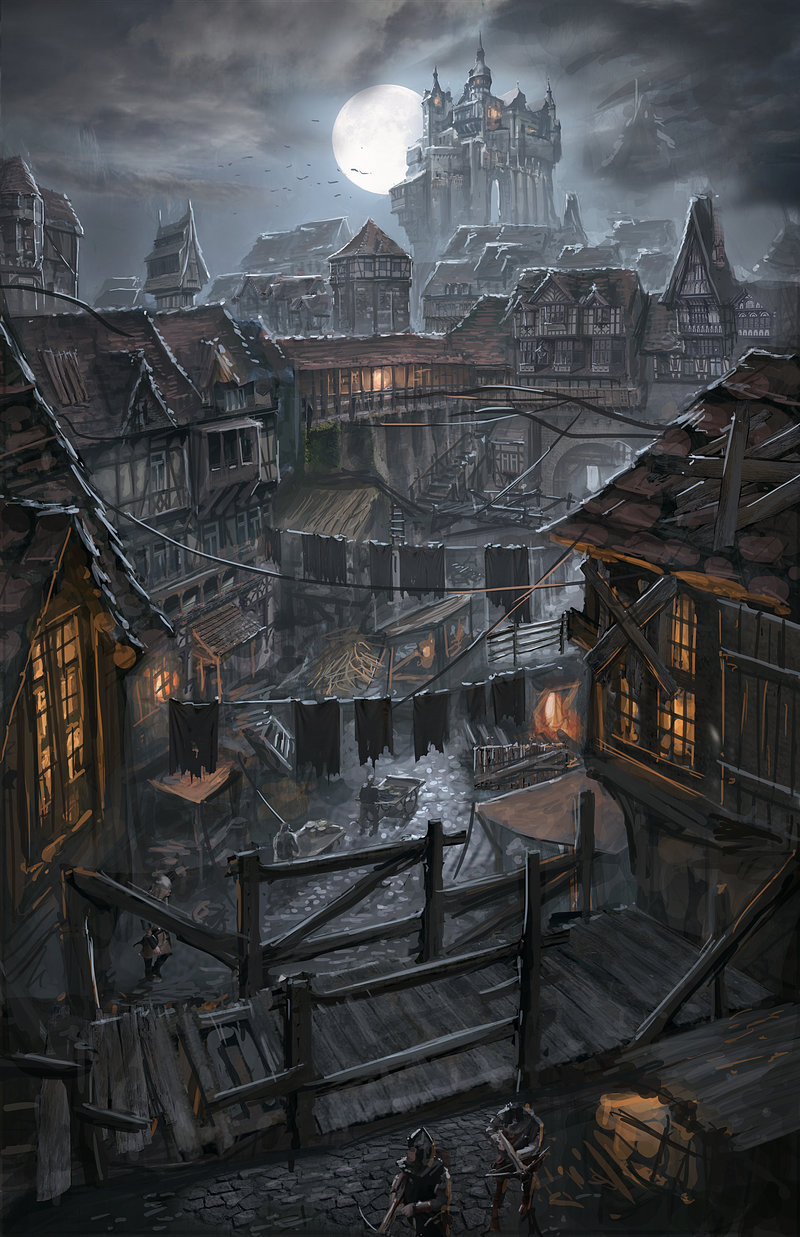
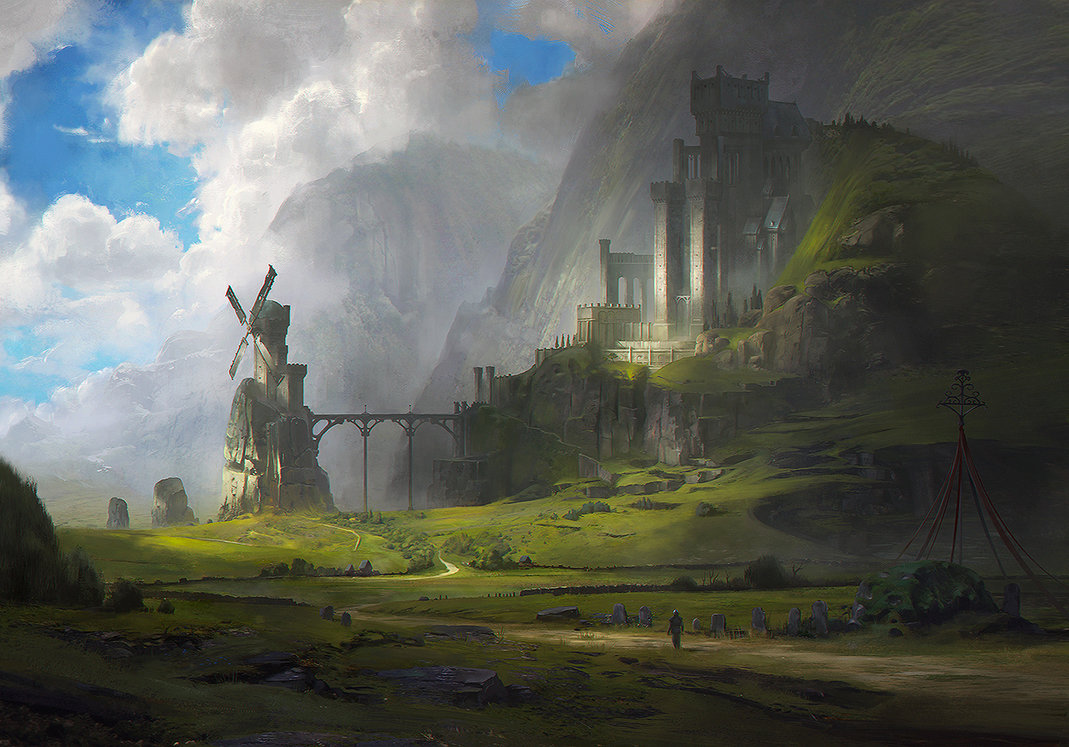
Castle Dra'ithkyrn
Ancient, stately, and ominous. Castle Dra'ithkyrn and its towering spires adorns the Caspez Peaks high above the village of Spinehollow below. From here Baron Dra'ithkyrn holds the lone seat of power in Lontharvia and executes his reclusive rule over the land from afar.

Spinehollow
Spinehollow sits in the mists between the Shivering Pines Forest and Castle Dra'ithkyrn in the Caspez Peaks of Lontharvia. A village with few sunny days as the cold skies stay overcast even when the rains aren't falling.
Places of Interest
- Location
- Location
*Proprietor: *- Location
*Proprietor: *- Location
*Proprietor: *
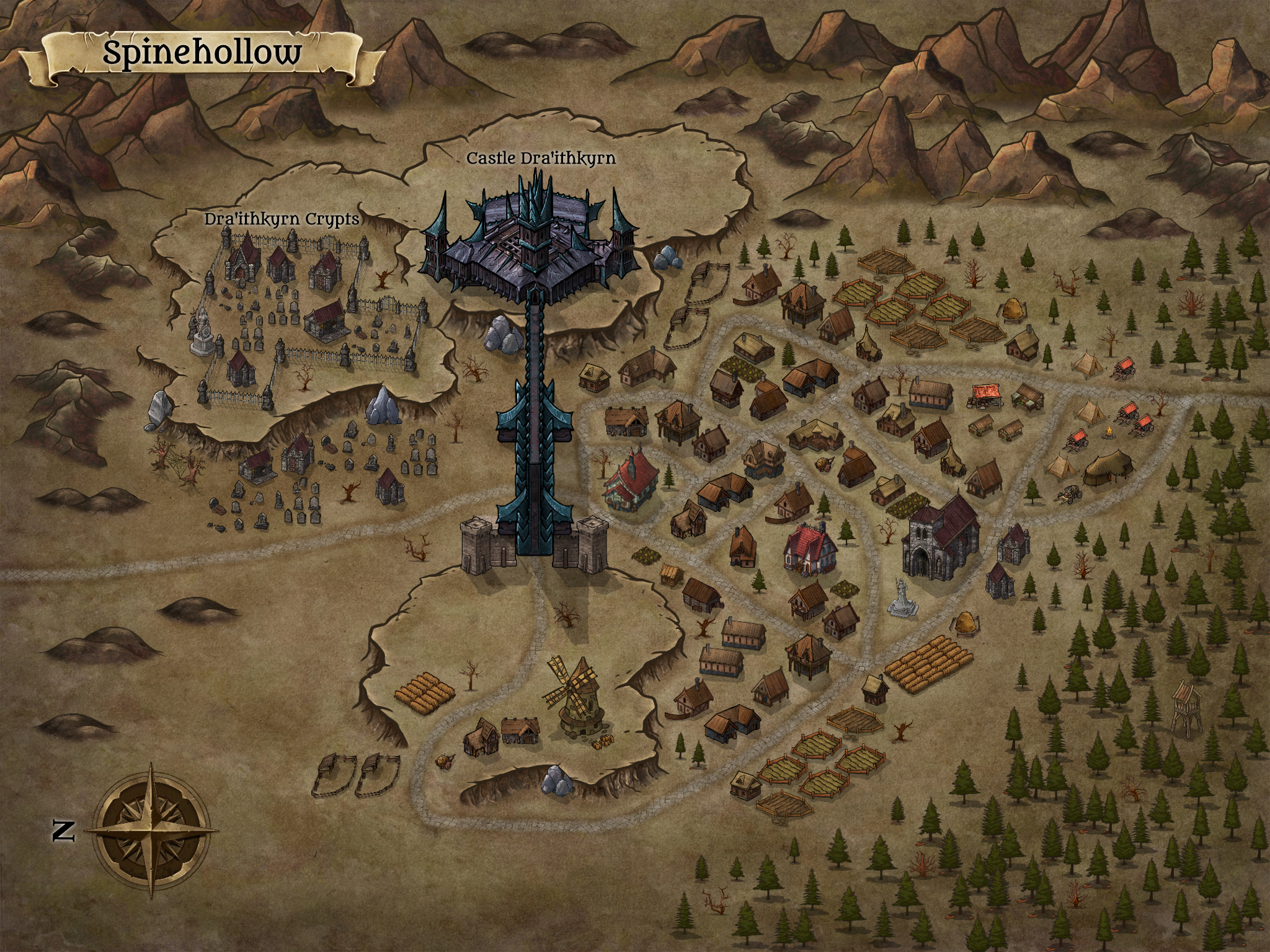
Spinehollow Map
VIII
Hollowdown
(The Underdark)

Beneath the Surface
Hollowdown is the name given to a vast subterranean network of twisting caverns, gigantic caves, and underground waterways that weave below the lands of West Elrithorn. Its formation is thought to be a mystery even to the ancients, for the Ith'inaar only discovered it during The Darkfall. Yet the Hollowdown is home to many civilizations who live their existence in darkness, both primitive and advanced.
Largely unexplored with numerous entrances to the surface, the Hollowdown acts in many ways as a dark mirror to the world above. Underground cities of dark dwarves, dark elves, and reptilians engage in war, trade, and schemes against each other and even darker forces such as beholders and mindflayers.
The landscape below varies greatly between gigantic luminescent fungal structures, massive underground lakes and waterfalls, to towering stalagmite spires and chasms. Each teeming with life that has adapted to the treacherous depths.
Visits to the surface are rare as most who dwell below find little interest in affairs above. Also, most have vision attuned to the low-light or darkness and suffer from sensitivity in the daylight. As such, all are almost exclusively nocturnal trips.
Known Entrances
One can never be sure if the mountain cave they've sheltered in for the night, or the hidden cove they've sought refuge in is connected to The Hollowdown. There are however some well and lesser known passages between the world above and below.
Crenmantle
Below the mines of the Crenmantle dwarves, where the Ith'inaar experienced their dark communion known as the Darkfall.
Scattershard Mines
In the Steamlands of Harrn deep below the mountains the Scattershard Mines cut deep enough to eventually lead to The Hollowdown.
Caneari Cove
A seemingly out of place rocky hollow in the shore of Caneari Lake that leads to a series of caverns which lead to another subterranean lake connecting to Hollowdown waterways.
Caspez Peaks
There are thought to be many entraces to Hollowdown in the Caspez Peaks and Shivering Pines Forest around Lontharvia.

Notable Locations
Pulanthor's Scar
A giant gash that cuts deep into the ground even from the elevation of Hollowdown, Pulanthor's Scar leads to even deeper depths and has no known bottom.

Caverndeep
Duergar city at the end of Pulanthor's Scar, Caverndeep is carved into the rocksides.
Hell's Heart
Lake of fire and lava at the far edge of Pulanthor's Scar

The Underbarrens
Large expanse created by a series of gigantic caverns. Unlike other parts of The Hollowdown, The Underbarrens are much more open and seemingly devoid of walls.

Lake Trelyrr
Far below Caneari Lake in Dalreon lies another large body of water. Lake Trelyrr is fed from both above and below and is a main source of much of the water travel in Hollowdown.
Thistledrop
Waterfalls and giant thorns that connect the Caneari Cove near Albrynn in Dalron to the underground lake below.

VIII
Magic

Magic by Realm
The term Magic encompasses any form of manipulation of the material plane on either the elemental or vibratory level without physical contact or understood science.
Magic is diverse depending on geographic region. As the races of man scattered, various cultures retained or forgot segments of the overall wisdom of the ancients. The term magic, is also a subjective one. What's considered mythical to one group of peoples can be commonplace or scientific to another. Most accounts of ancient arcane magic is recorded in the Tome of Koth.
The highest retention of practical arcane magic is in Shalihir since they are direct decedents of Solvheil. Those that survived the expulsion of the Imlan Sea and the crumbling of the city became nomadic tribes as the basin became desert. After a rebellion against magocracy in the Age of Burning Towers, those tribes eventually consolidated in part to form governmental structure in Quil N'aair. It is not uncommon to find a desert mage in any town, encampment, or party in Shalihir.
The kingdom of Dalreon is comprised decedents of Kazatharis survivors. Until the flood they had respected the Great Forest that spanned the West. After the sea spilled over the mountains, they took to the clearing the forest as they made their way South. Because a majority of the arcane stayed behind and perished attempting to reverse the flood, and soured relations with the Elves of the forest, magic by and large faded from the populous.
The Elves of Lyritholln are mainly druidic with the magical abilities utilizing nature in their defense of the land. They are most powerful when found in the forest due to the density of vegetation. They do possess some arcane ability as the alliances of old saw intellectual exchange between them and the old kingdoms of the sea.
Harrn in the North is home to both the large stature rugged humans, as well as the mountain dwelling dwarves. Unlike Dalreon there are open relations between the races and their minor magics have been exchanged. This blending has brought about both runic magic of the dwarves, and the shamanistic practices of the Harrn. Both practices revolve around elemental magic as does their respective religions.
Orilyn is arguably the most magically diverse of all the cultures. Not only do they possess some traditional arcane magical practices, they also boast sorcery, or what is known to them as "Fire without Parchment", in large numbers. Those that follow the path of a Sabaril Warrior also begin to develop great mastery over body and the surrounding energies. They can focus their field to perform vast feats of telekinesis and superior physical prowess.
There are also those who have an innate ability to use chaos for magical purposes. These Warlocks create spells through bends and tears in reality and creating small amounts of raw chaos at will. They are not limited to a specific geographic area, but instead are a rare occurrence across the land. Warlocks usually live in solitude, in secret, or in a prominent position within a rural tribal structure. Some scholars propose they are a result of the events that led up to the ancient flood and accounts of strange shifts in reality shortly before. These theories are met with great skepticism, as are tales of demon bloodlines.

Types and Styles of Magic
- Arcane
- Demonic
- Divine
- Druitic
- Elemental
- Frequency Adjustment
- Gemcasting
- Runic
- Shadow
- Shamanistic
- Sorcery
- Spellsinging
"Before one can understand the segregated schools of arcane magic, they must grasp the composition of the material world. To start at the beginning one must understand the separation concept of Order and Chaos. The lack of definitive pattern is not conducive to creation, and the endless flux of Chaos had to be manipulated to create forced repetition of frequency. Once a haven of Order was established it was secured and expanded thereby pushing Chaos beyond its borders.
From within this bubble were the elements forged. Fire, Earth, Air, and Water are the four elemental planes of existence; which intersect in a planar sense to create the material plane. At said junction, their frequencies are within harmonious range with each other which allows binding within a common spectrum. This spectrum represents the material plane that resembles each of its four elemental cornerstones bound to a common linear timeline.
The outskirts of this spectrum are protected by a membrane, or veil that both contains and shields its singularity. Transition between the material world and an elemental or outer plane must take place through an opening or portal in this veil or through proper frequency adjustment.
Within this plane, Material and Energy are but two sides of a coin; merely the same substance in various form. Energy comprises Material when held together within a tangible frequency, and Material can likewise be transformed to energy with proper vibrational adjustment."
-from the Tome of Koth
Arcane
This form of magic must be studied to perform. Humans may be susceptible to Mage Madness at higher spell levels.
Arcane Spell Schools
- Abjuration
- Conjuration
- Divination
- Enchantment
- Evocation
- Illusion
- Necromancy
- Transmutation
Abjuration
Abjuration is the practice of arcane reversal by either direct effect on a magical or physical property, or setting up a preemptive barrier. It often deals with the polarity of a given target and countering it with an opposing force.
Conjuration
Conjuration involves summoning from either within the material plane or from one of the outers. Its practice revolves around the knowledge of physical spatial limitation as well as the creation and use of various portals to bend distance.
Divination
The process of Divination entails sensory perception without the use of affiliated organs. By allowing the mind to act as a receptor to information, physical limitations of experience are thereby circumvented.
Enchantment
Enchantment deals directly with control over a creature or inanimate object. It involves adjustment to the properties of the subject in either a physical or mental sense.
Evocation
Evocation deals more directly with various forms of energy than the other schools. Commanding the path and form of energy tapped from either the material or outer plane and channeled through the caster, Evocation is often considered one of the most volatile styles.
Illusion
The ability to alter perception based on manipulation of the known physical senses within ones self or in others. Illusion often resembles Conjuration and leaves the subject armed with his own disbelief to make the distinction.
Necromancy
Within the material world exists a natural cycle of birth, life, and death. The interference of this cycle whether to slow or expedite the process is referred to as Necromancy.
Transmutation
Transmutation involves the commonality of material and energy. Adjustment to the vibrational pattern of either can result in a dramatic change of form. Often an intimate knowledge of the elements and their ratio is required for successful transmutation.
"Casting an arcane spell is like telling a good story, only to forget how it goes once you're finished."
Arcane Components
Material Components
Physical substance that is consumed during the casting process.
Material Focus
Physical substance required to casting but not destroyed in the process.
Verbal
Words are power, as they are will manifested as vibrational resonance.
Somatic
Posture and movement are often vital components of casting.
- Hands: The default method of casting involves precise movements of the hands and arms.
- Wand:s Rods held with one hand are moved in a pattern.
- Staves: Often used with arms outstretched or the staff pointed toward the target depending on range.
- Scrolls: Often if the spell is a targeted effect, the free hand acts as the extension of the spell.
Demonic
Chaotic magic tapped either through blood-ties such as that of the warlock, or dark rituals.
Devine
Granted by a Deity through devout reverence, the clerical subject acts as a conduit for channeled divine power.
Druidic
The manipulation of nature through elemental ties to life. Potency and relevance is directly related to environmental conditions. Nature is also prone to influence from auditory sources, for there are deep-rooted reasons why "Music soothes that savage beast".
Elemental
The use of raw magic from the base elements. Although in a minor sense, elemental magic is slightly divine in interpretation as the materials are represented by their respective

Frequency Adjustment
The art of casting itself is in effect the pulling of hidden strings that tie everything together. Much like the strands of a spider web, they are interwoven and respond in kind to the slightest disturbance. These fibers weave together in patterns and are found in all non-chaotic substances as the defining element of Order. They themselves are in constant and repetitive motion as they vibrate in sync with adjoining fibers. The frequency or rate at which they move is directly connected to their makeup.
Gemcasting
The alteration or amplification of magical energy through use of a crystal. Practitioners are often called Gemcasters.
Runic
Operating on the principle of power being executed by the spoken word and stored by the written, runic magic draws from sacred geometry.
Shadow
Dark magic that borders on chaos, Shadow magic is largely employed by the Zinyari of Orilyn.
Shamanistic
Tribal magic exercised by achieving altered states of consciousnesses through medicinal or mental means. Often involves elaborate ritual and material focus.
Sorcery
Flows from the individual user through sheer will like reciting a song. Most commonly found in Orilyn and attributed to their proclaimed draconic heritage.
Spellsinging
The alteration or amplification of magical energy through harmony and resonance. Operates on the ancient knowledge of energy and vibrational patterns.
"All men want power, you can only hope those that achieve it aren't mad"
Mage Madness
The use of higher arcane magic among humans has the potential to cause mental instability. Possible, but not confirmed, contributing factors are too rapid a progression of study, as well as practice of higher spell levels.
Subjects can suffer from a variety of symptoms, from temporary disorientation and loss of time, to full blown insanity.
The use of music and harmony can be used to not only alter spell casting, but to also quell the potential onset of Mage Madness. This is another reason for the mixture of spell and song in the ancient world.
"Tyrants build towers, Darv. It has been that way since Solvheil sunk into the sands."
"You imply wizards are tyrants?"
"The ones in Shalihir were. They enslaved the masses and forced them to erect their towers. They built grand pedestals to stand above everyone else. To look down upon the less powerful."
"Perhaps towers serve not as a way to look down upon mundane, but to escape it."
"So it has nothing to do with power?"
"Why should it? A tower can simply serve as a quiet place to read."
"Then explain to me why you've spent the past hour arguing with dwarven stonecutters about the content, dimensions, and alignment of a single brick."
"How would I be able to be at ease to read if I knew things aren't in their place?"
"Sounds tyrannical to me."
"Shouldn't you be in town at the tavern by now? I'm sure your musings are appreciated there."
"Among the mundane?"
"Precisely."
-Darvynus Dauntora and his resident bard
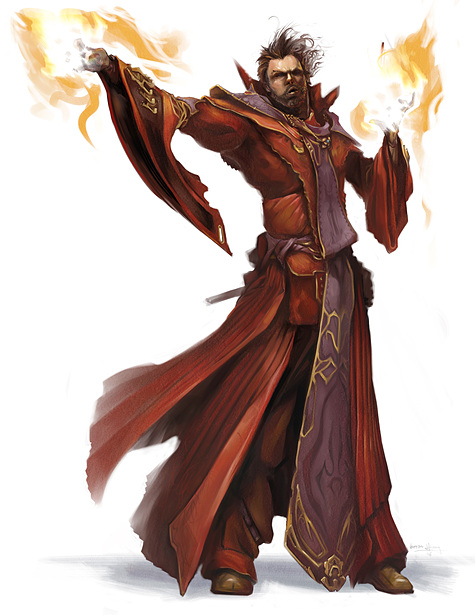
Mage Madness
Upon casting 5th or higher level of arcane spell human casters must make a roll determine if they succumb to Mage Madness. The likelihood and severity increases in regard to both the level of the spell and the level of the caster.
The effects can be as mundane as temporary forgetfulness or a passing quirk to as severe as blindly attacking party members or permanent insanity.
There are precautions that can be taken to alleviate the onset of Mage Madness, but there is no known cure. This affliction does not appear to affect any other race but human.
Example Effects:
You may also use the Madness table in the 5E DMG
- Light sensitivity causes constant blinking.
- Talking to inanimate objects as if they are intelligent.
- Loses voluntary motor control of right arm.
- Begins to yell out loud the names of everyone and everything they see.
- Keeps leaning to one side and insisting the ground is uneven.
- Convinced everyone in the party is conspiring against them.
- Believes themselves to be invisible despite being reassured they are not.
- Confused on current era as conversation seems to jump through different times.
Most of the content contained in this guide was most recently archived here